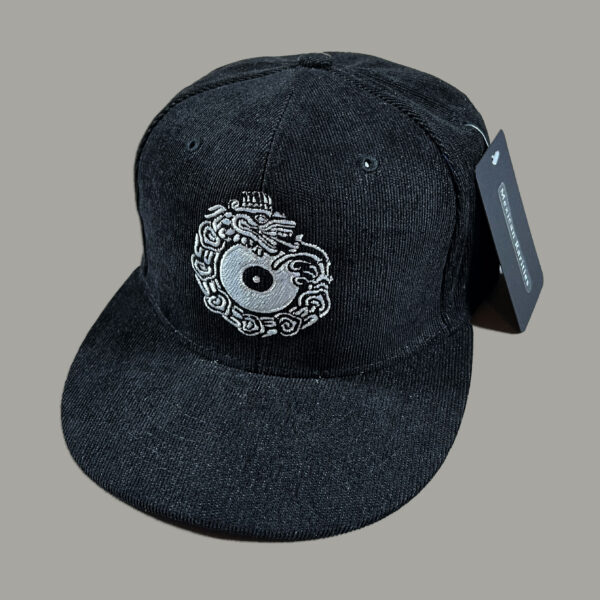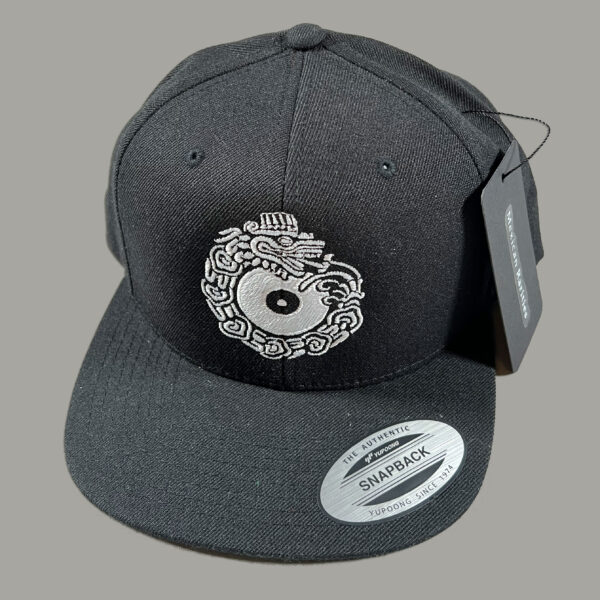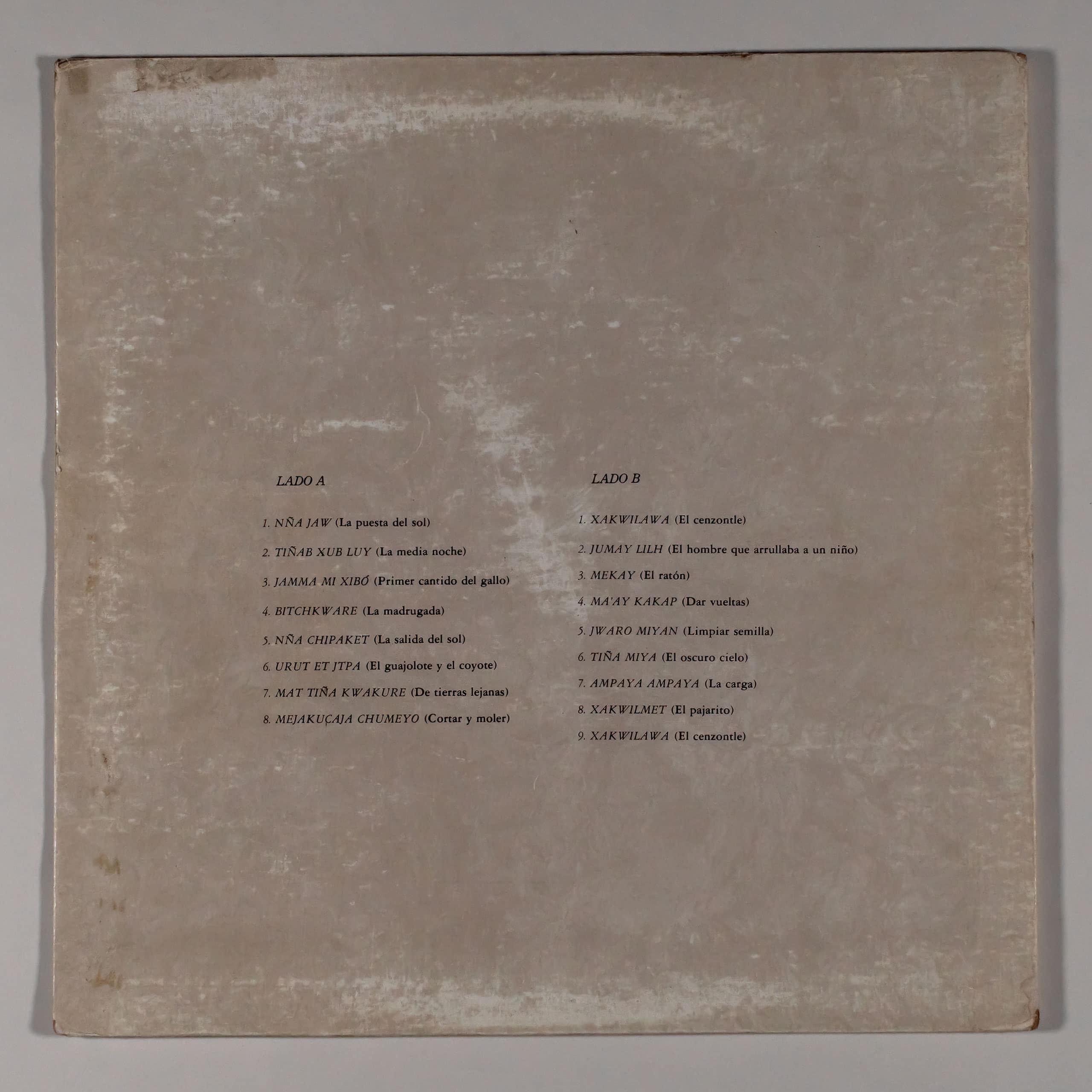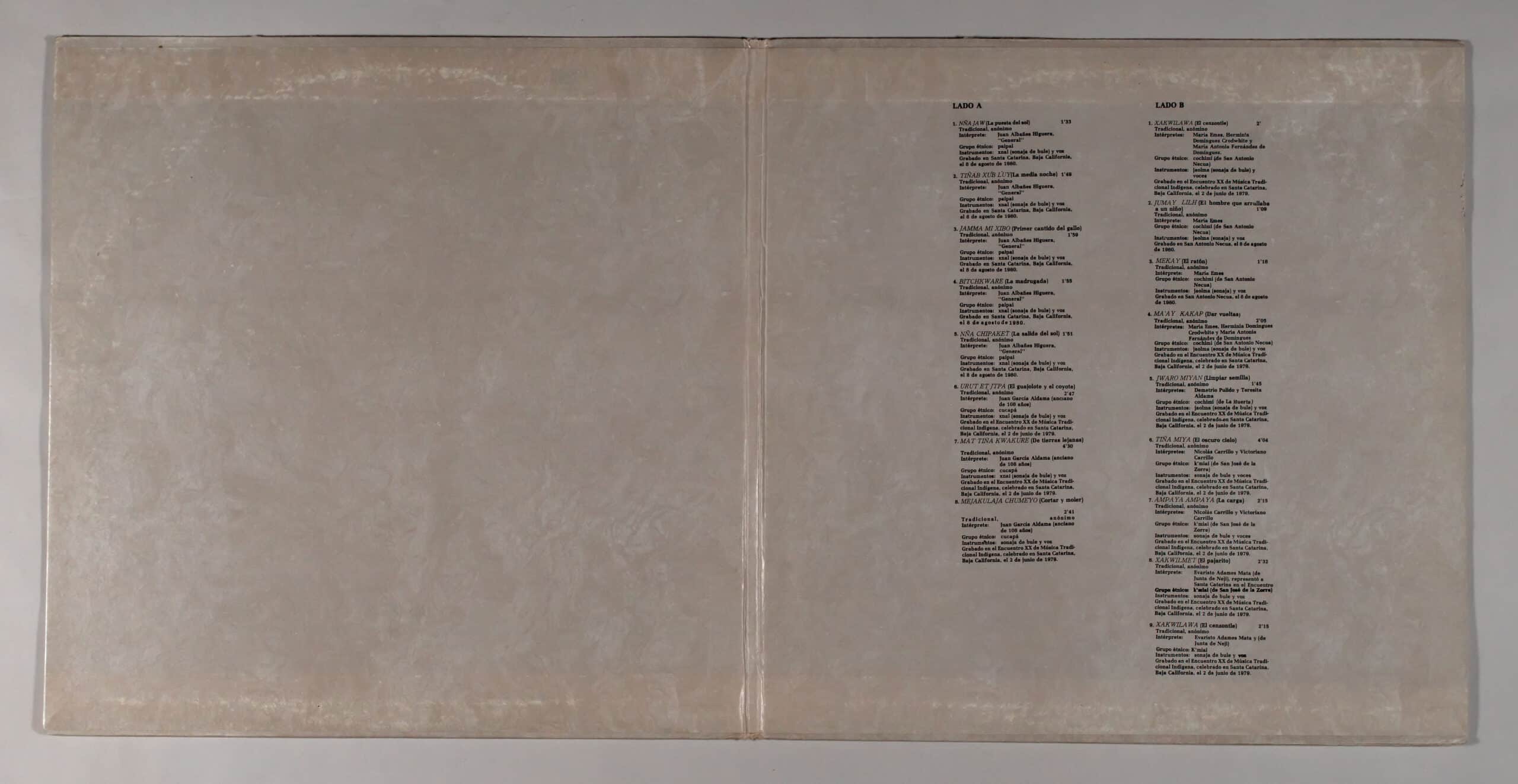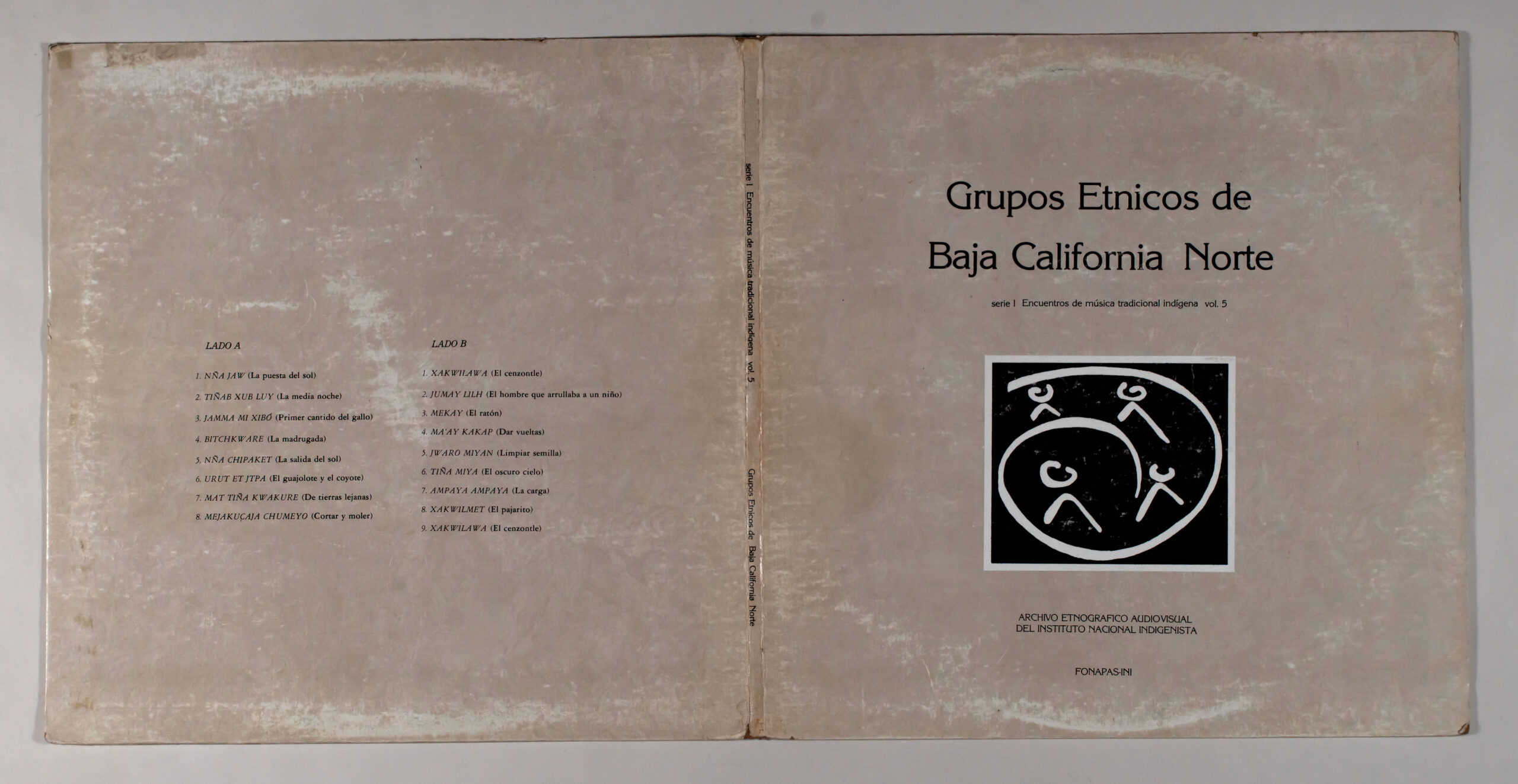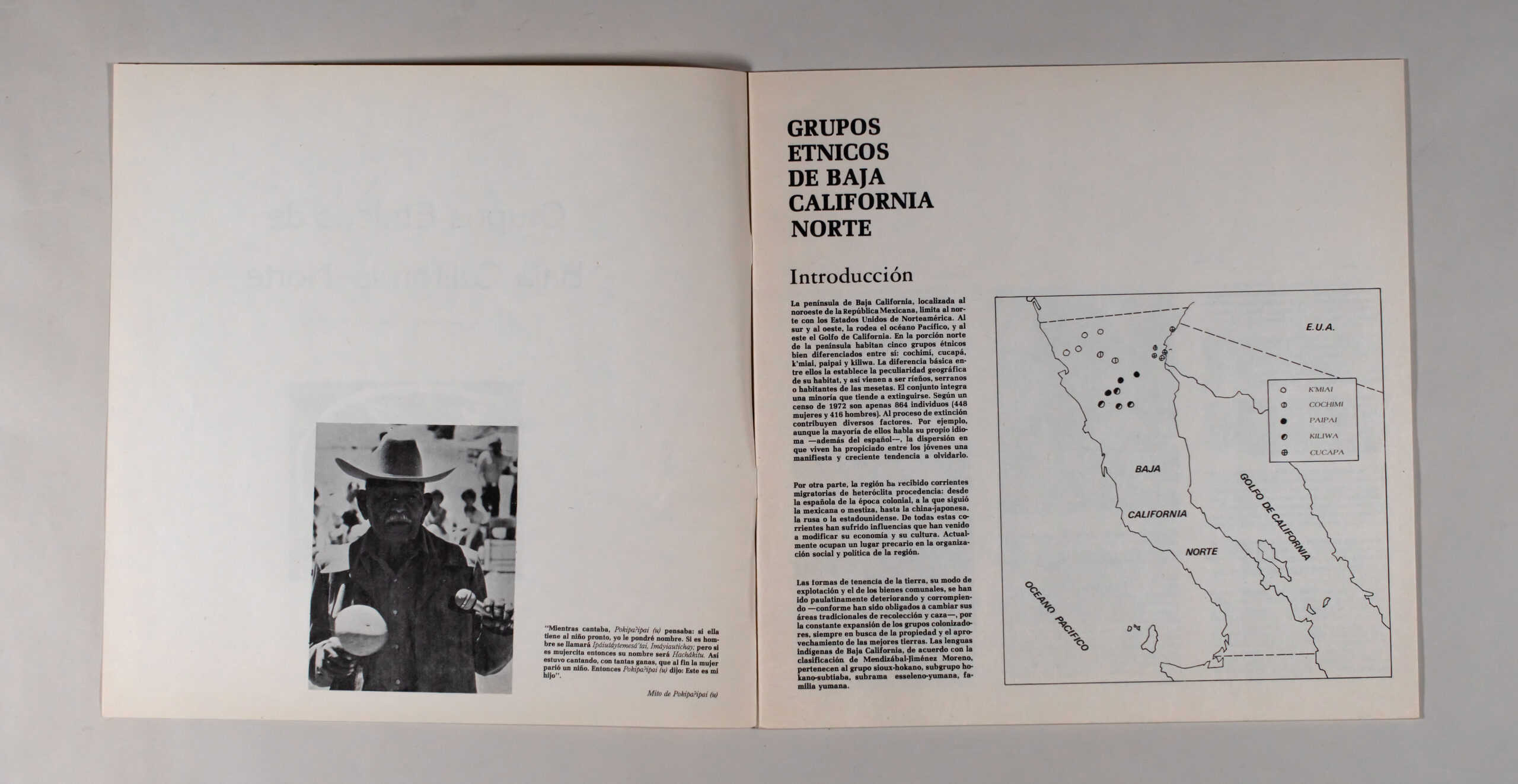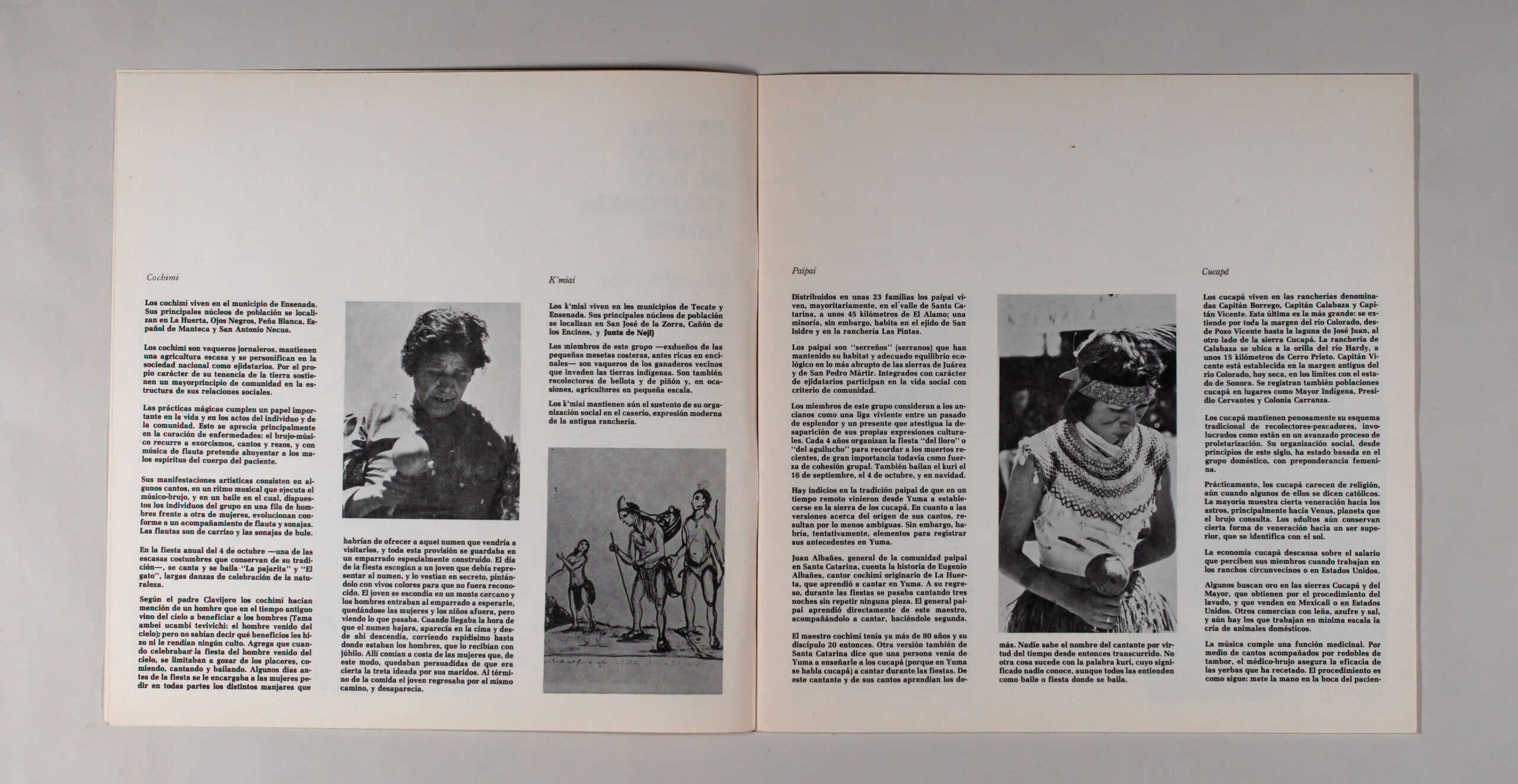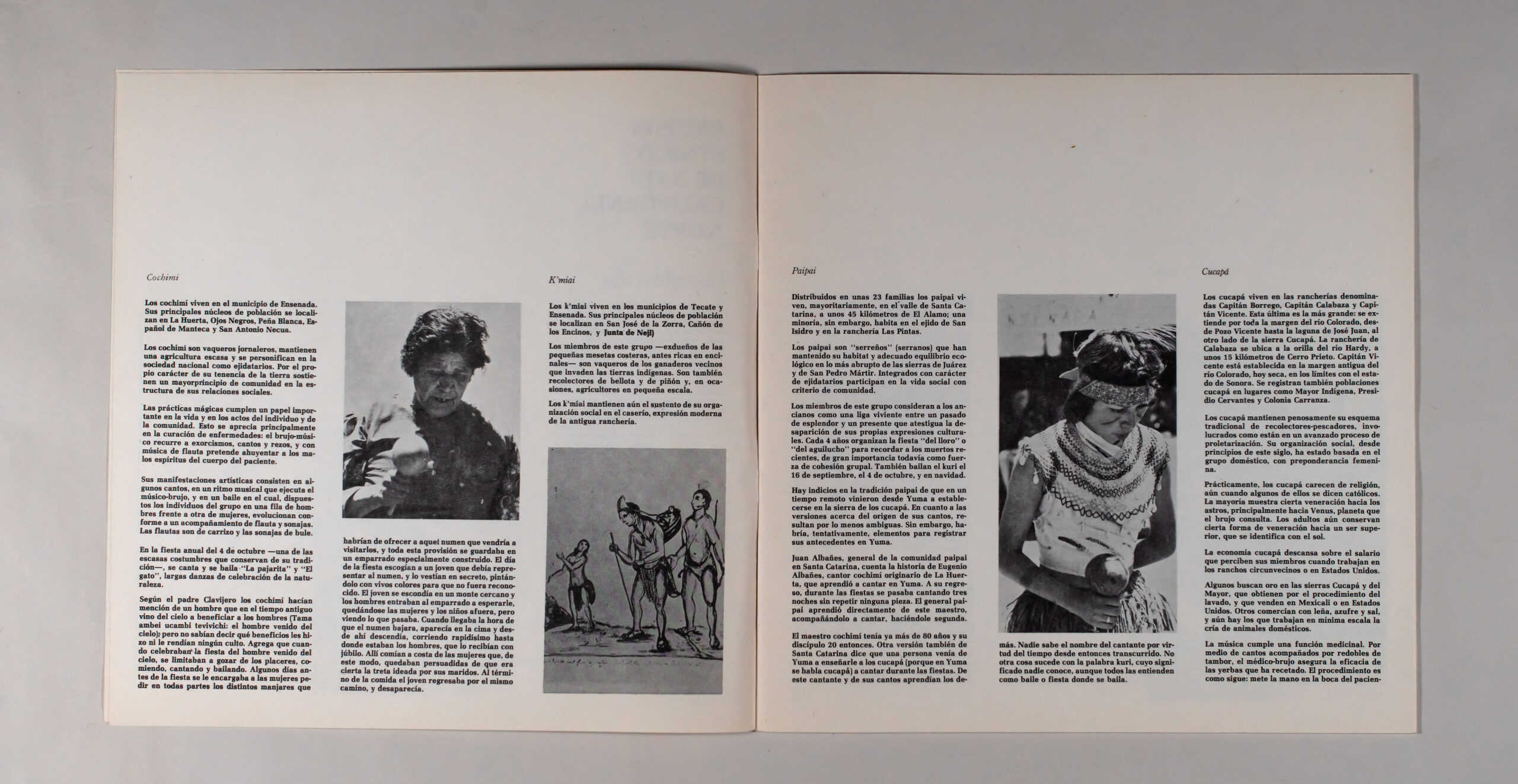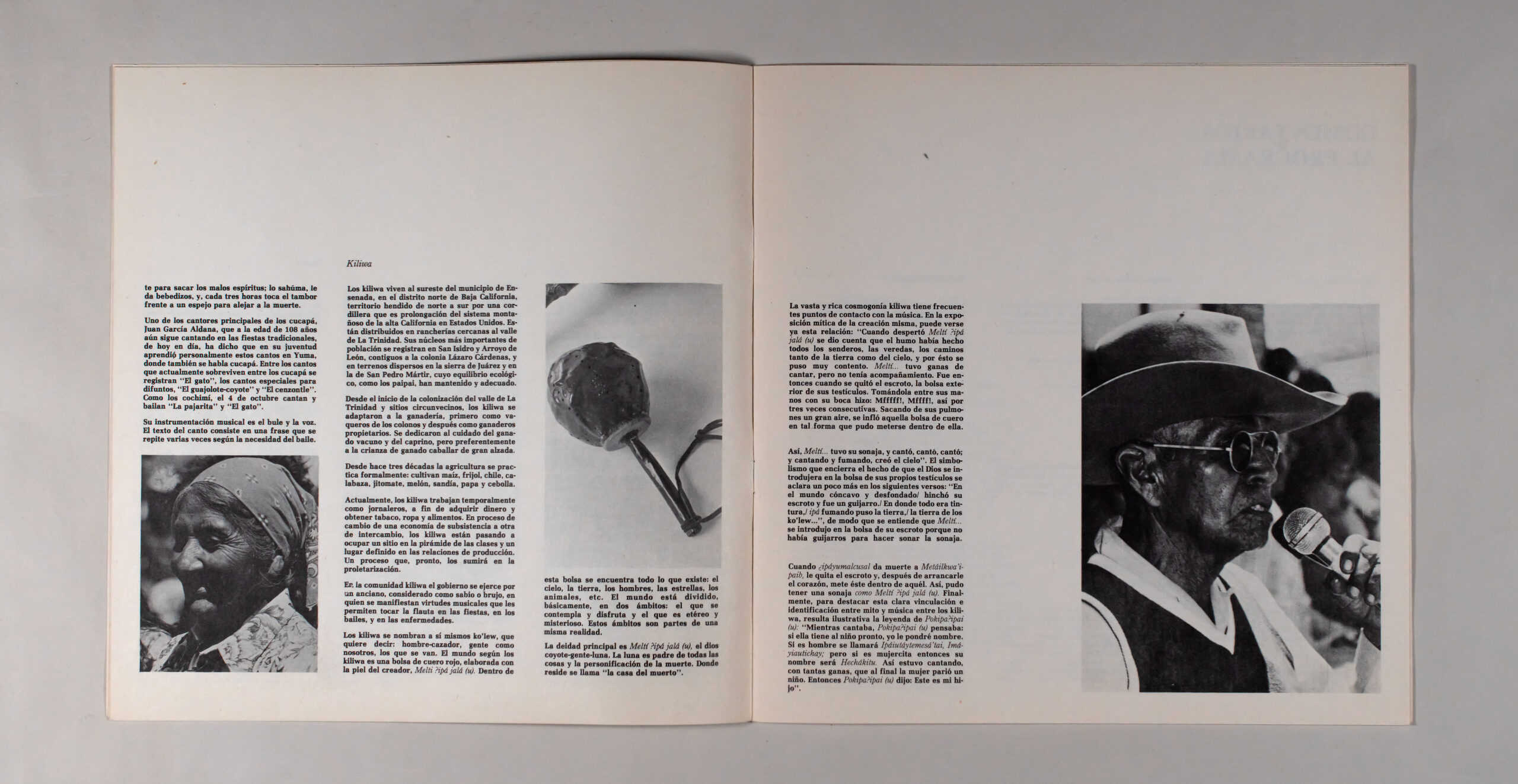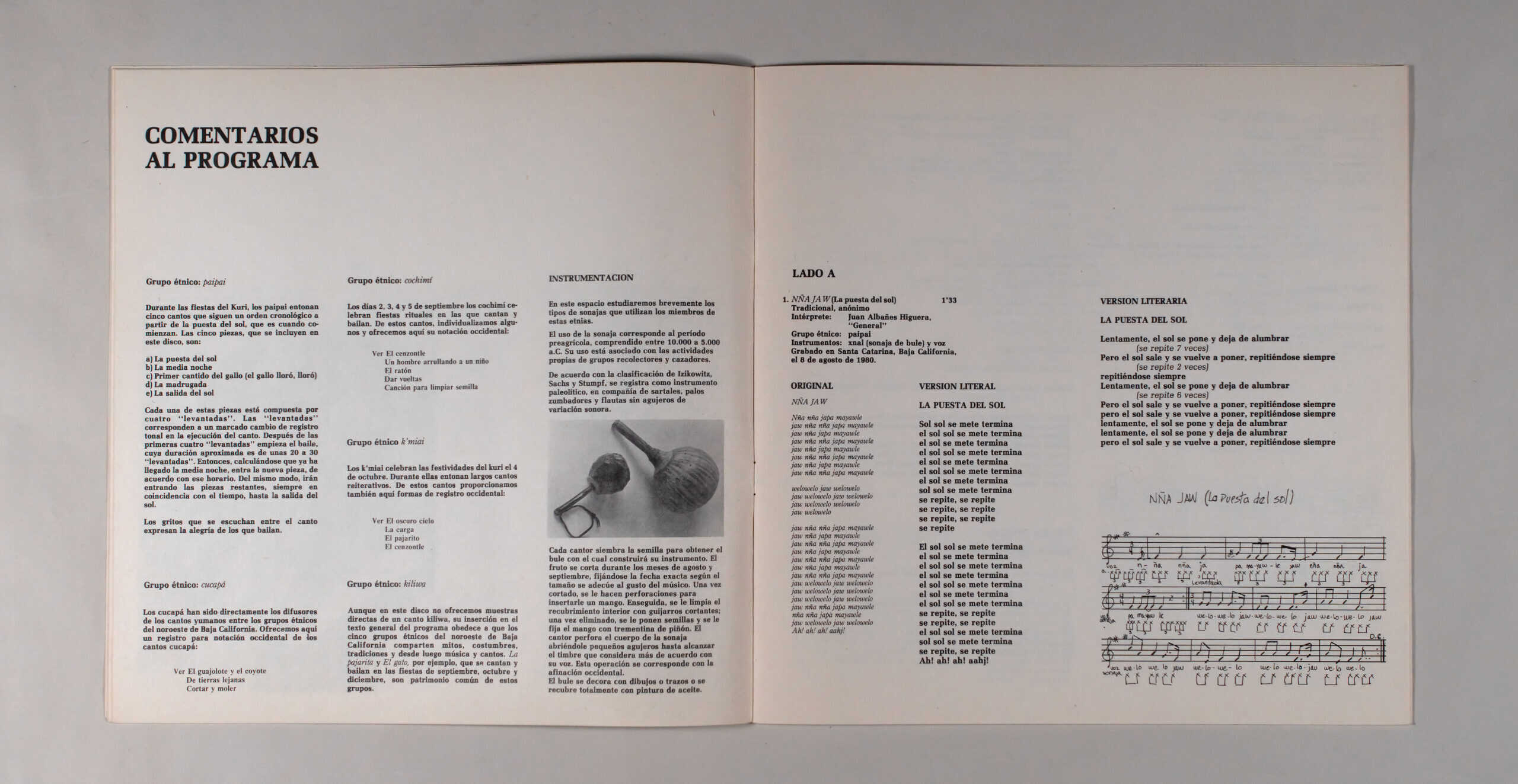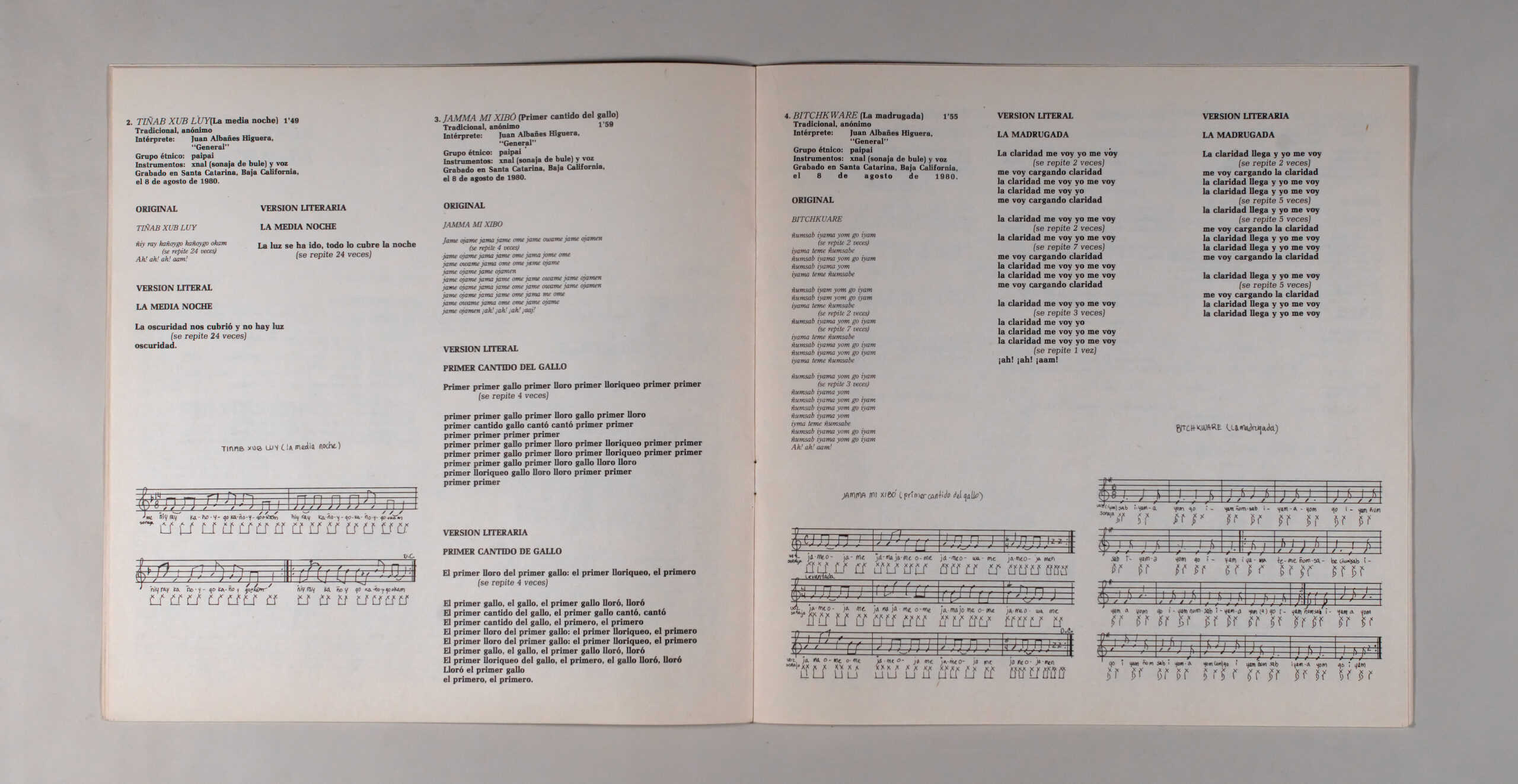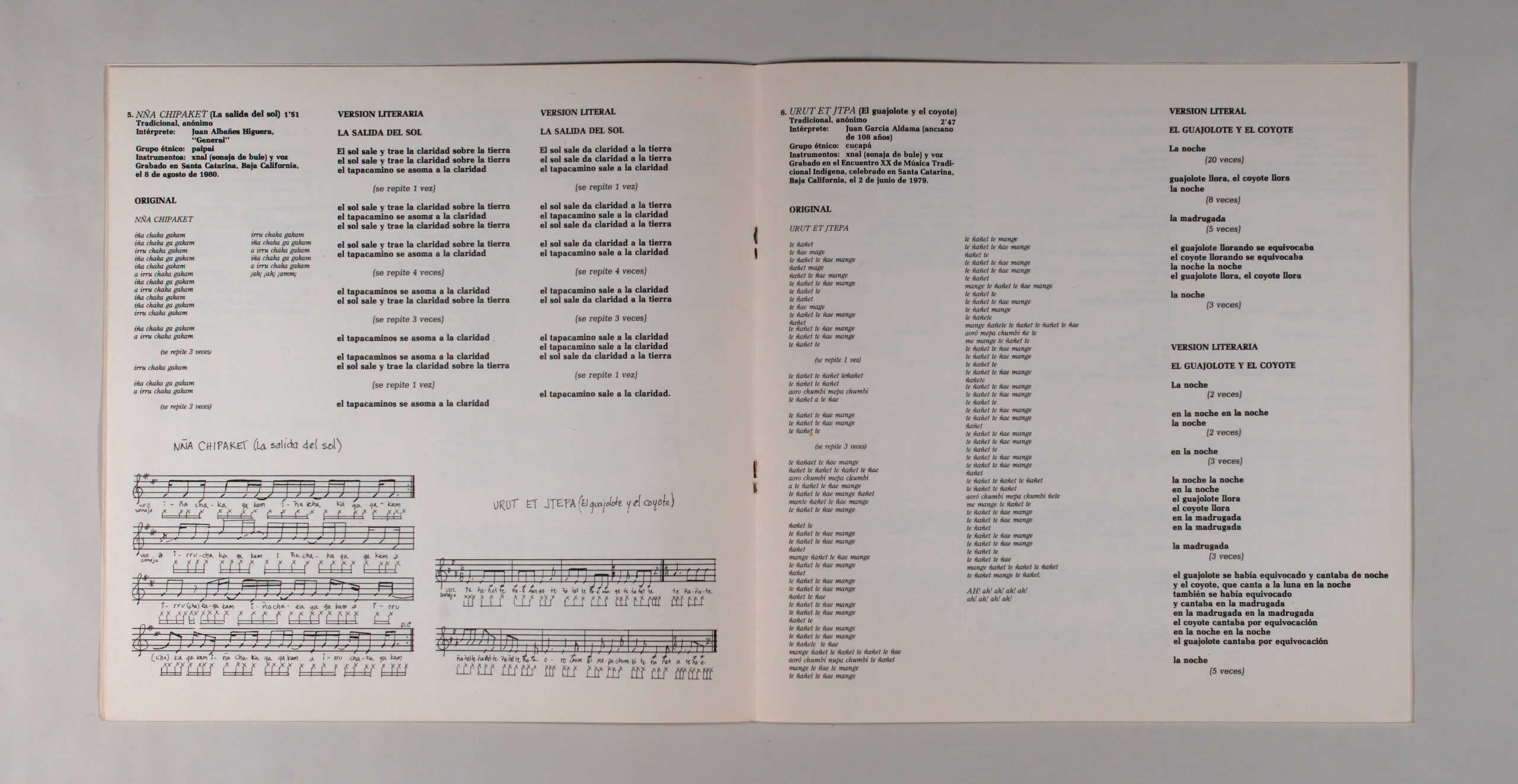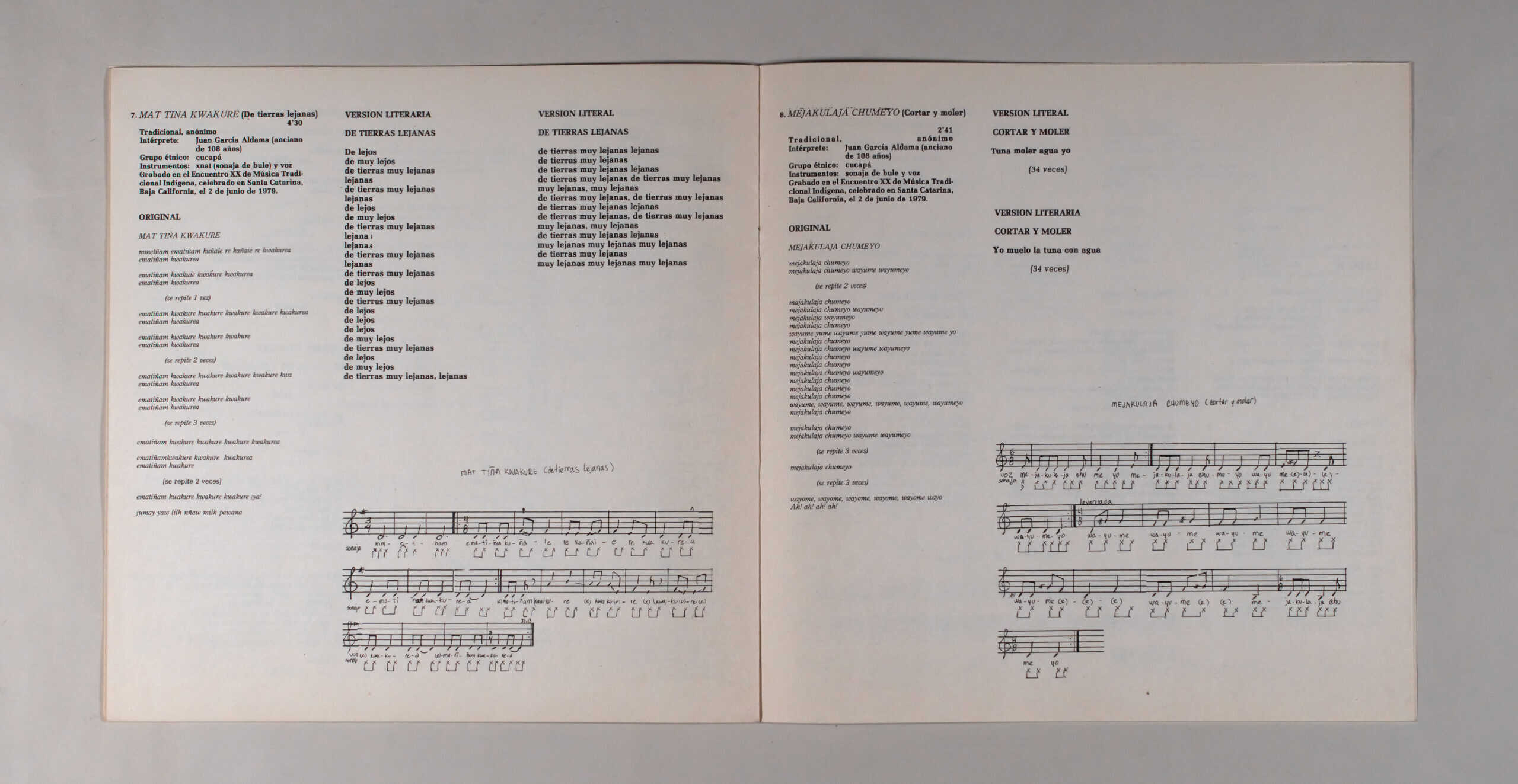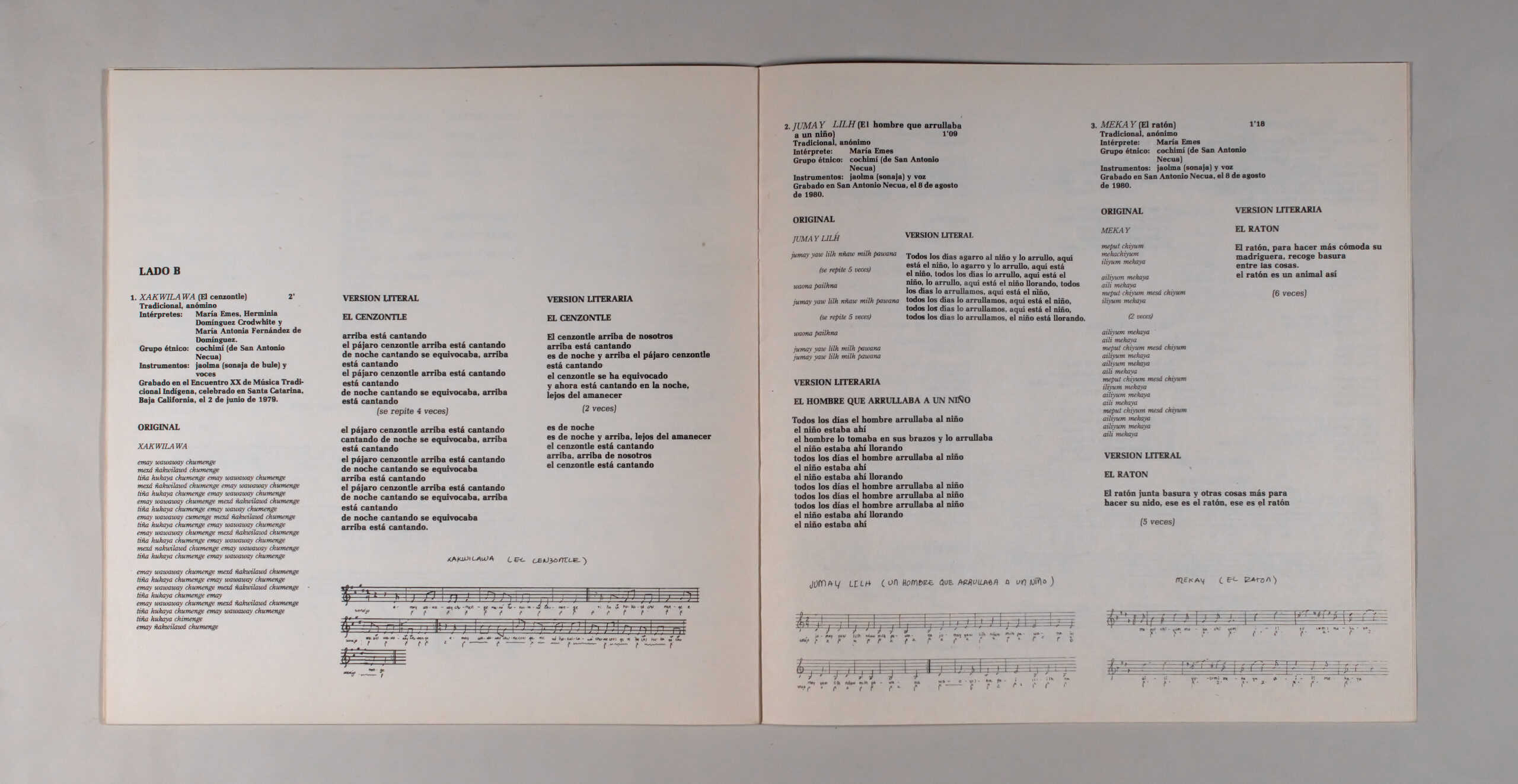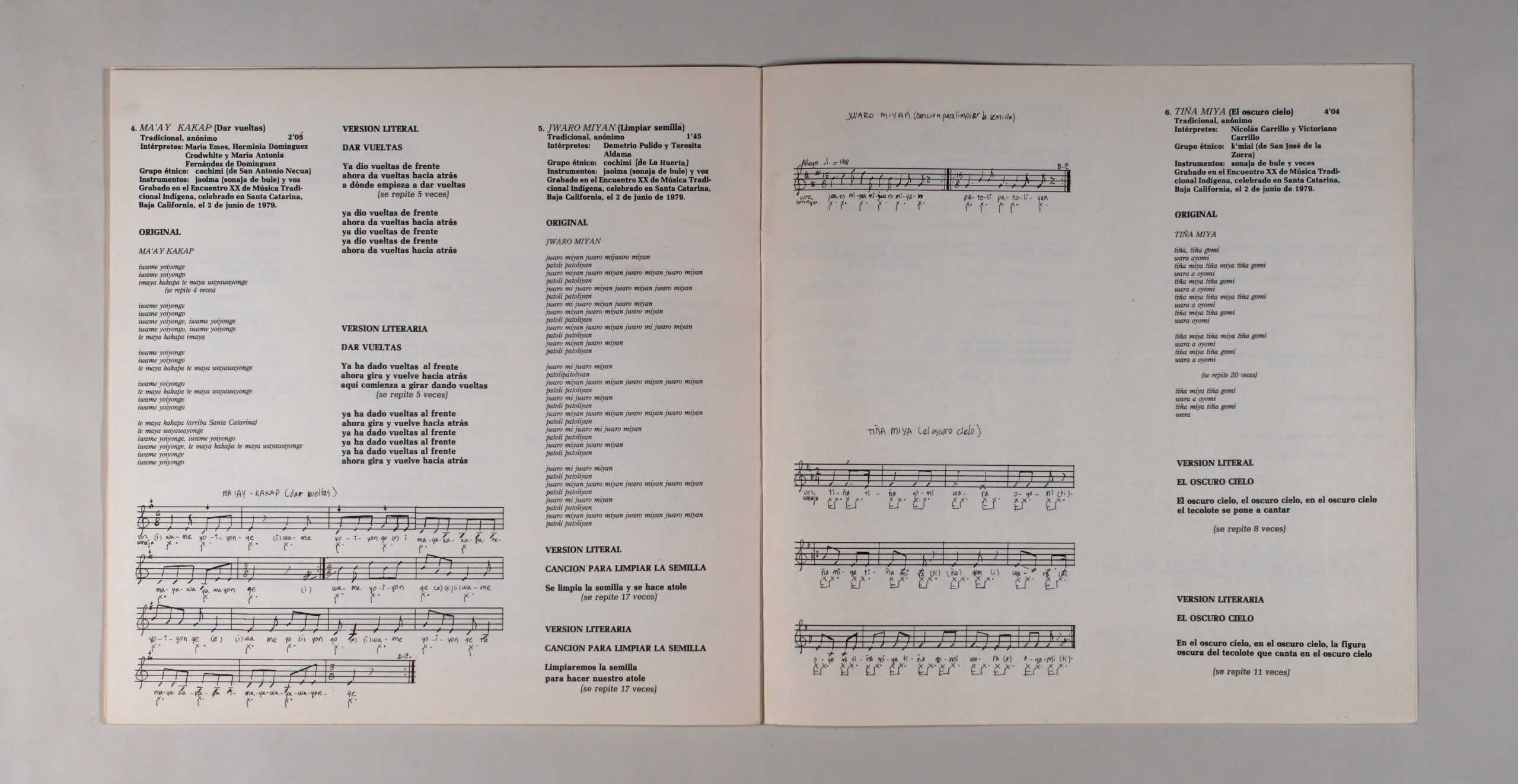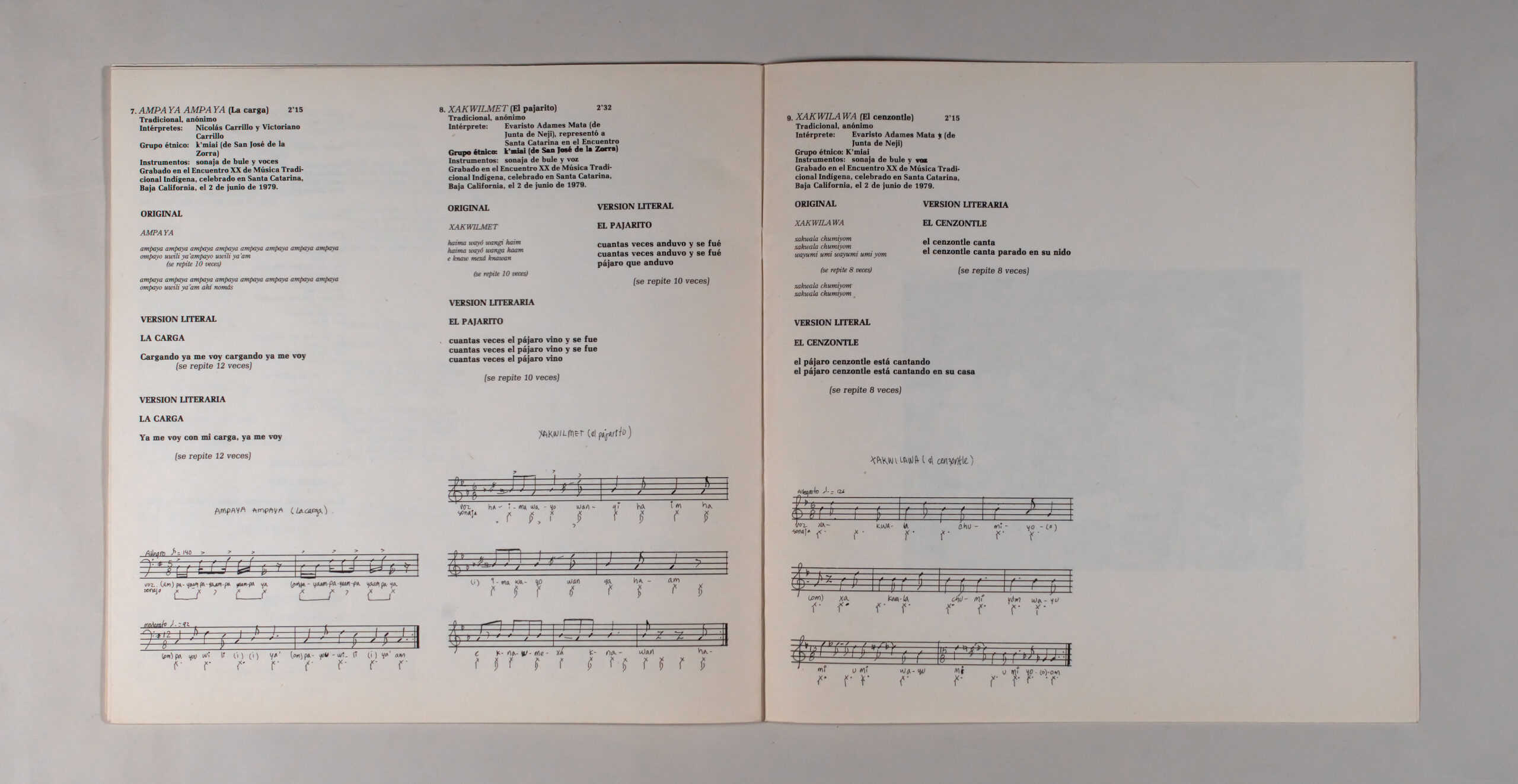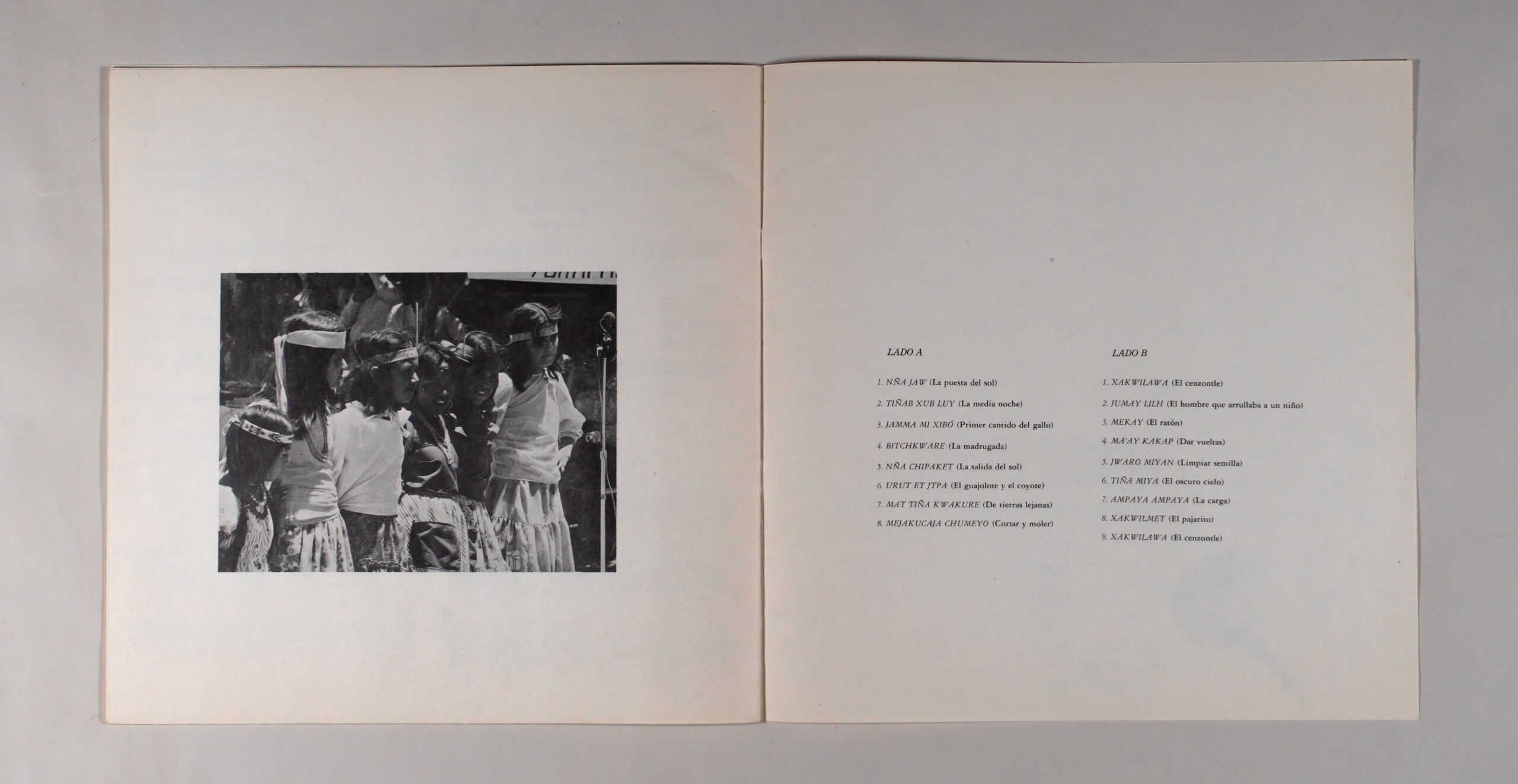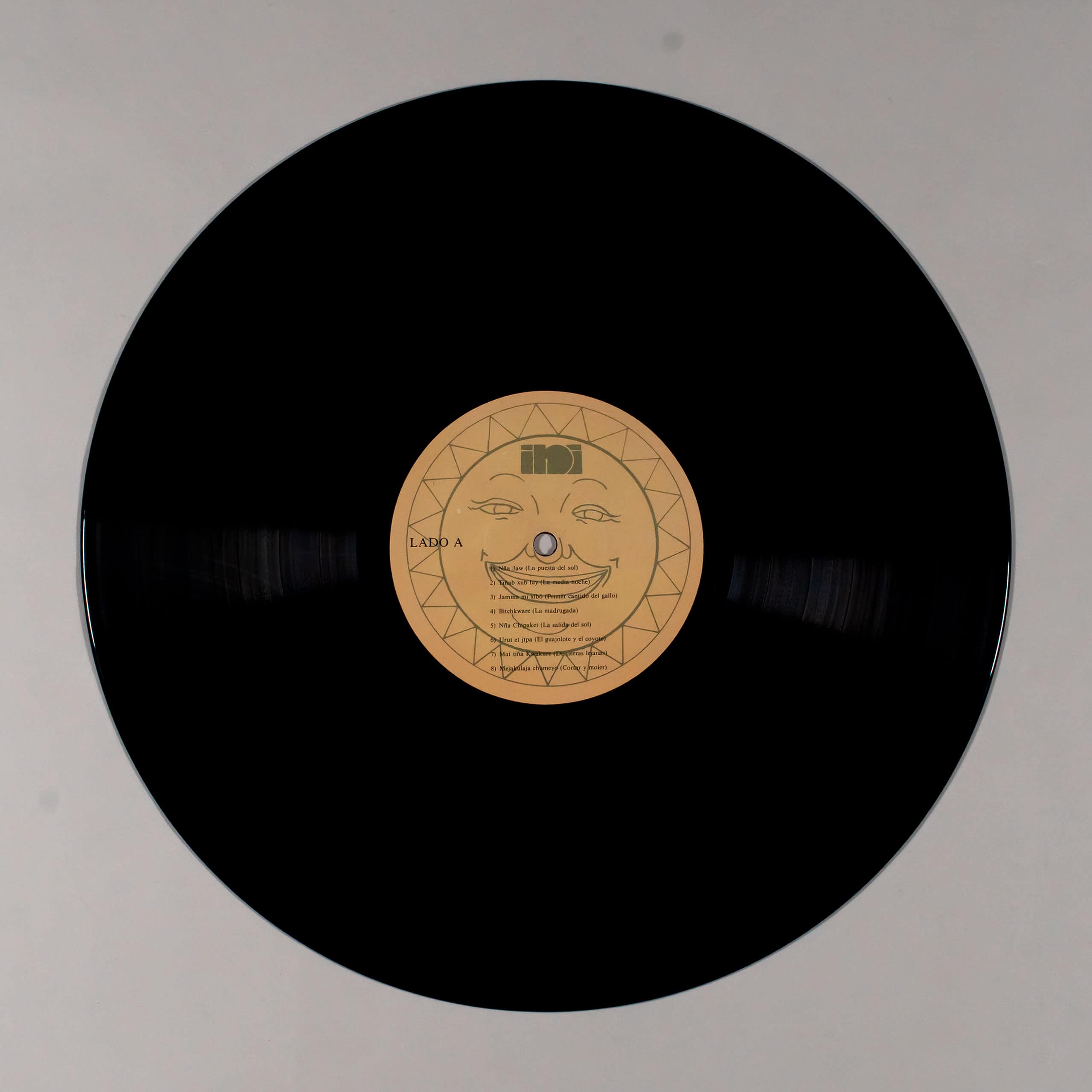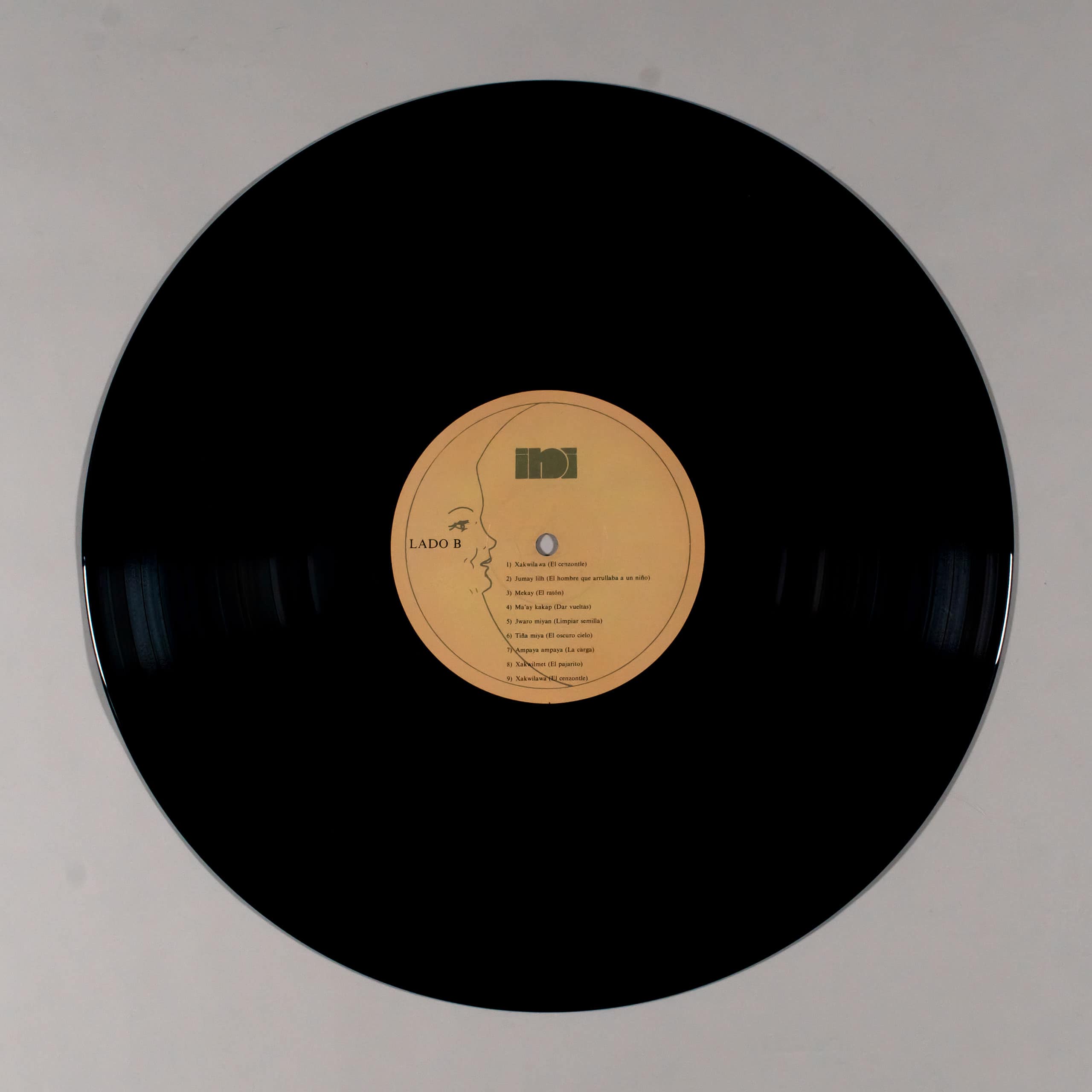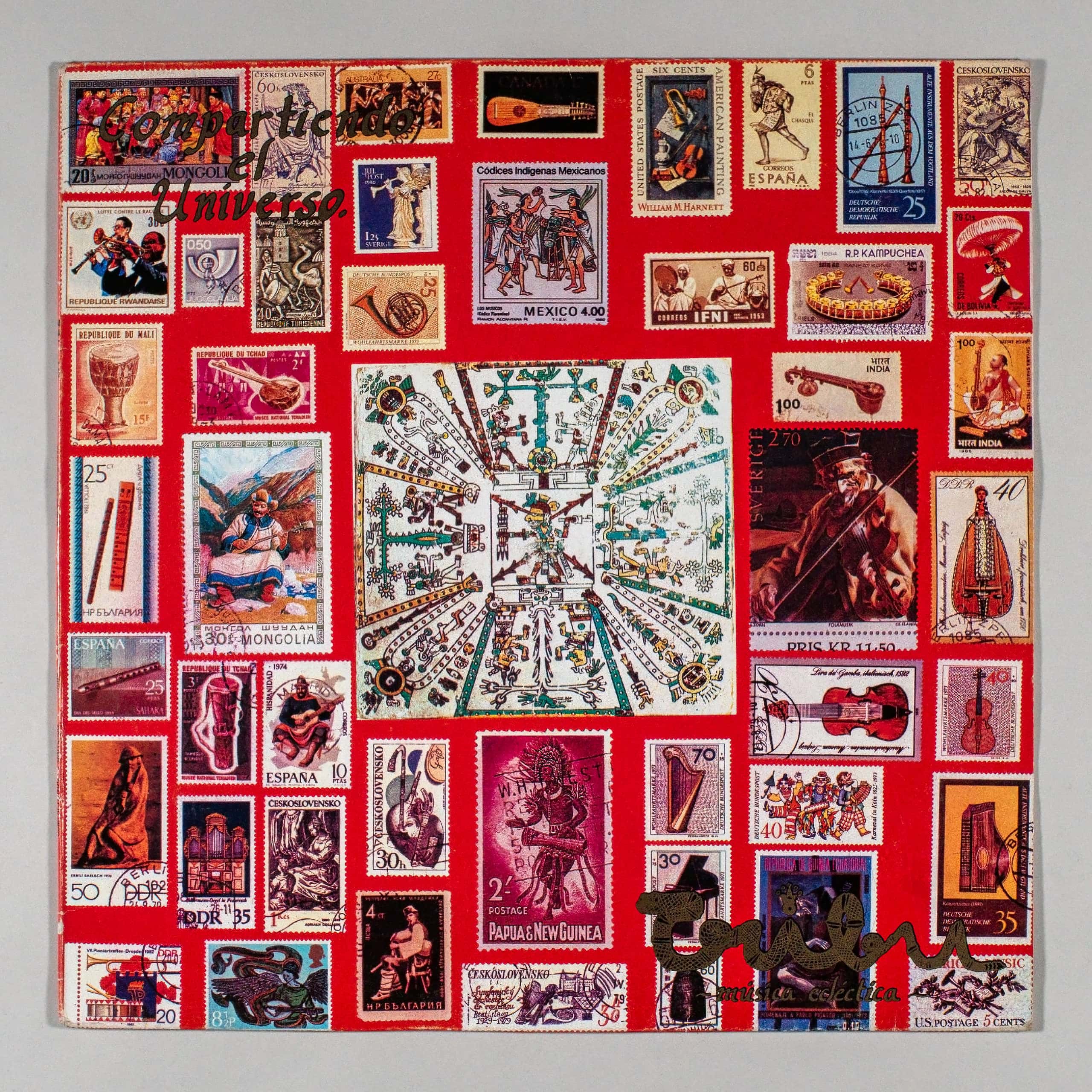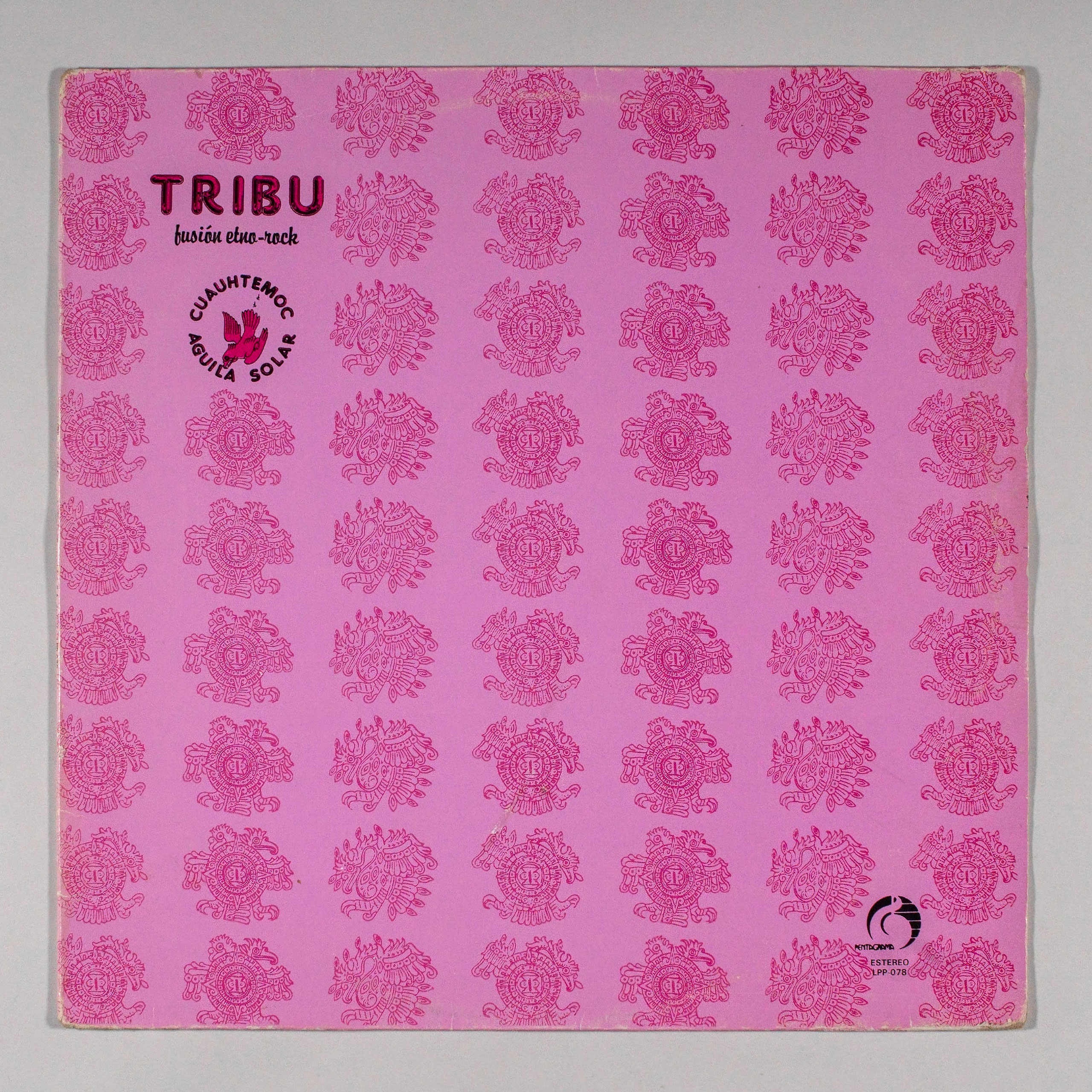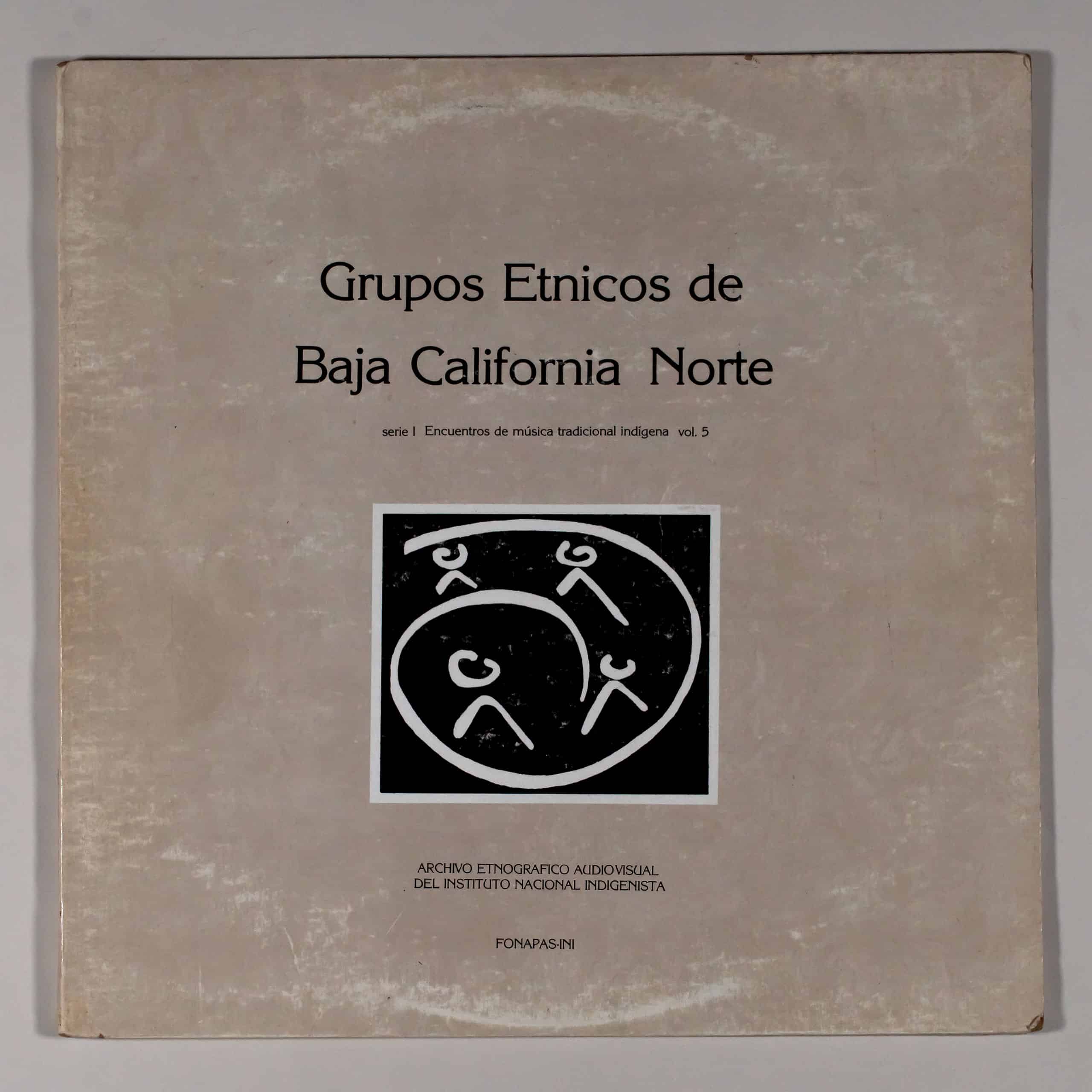
|
Label: FONAPAS-INI SERIES I, VOL. 5 Released: 1980 |
Country: Mexico Genre: Folk World & Country |
Info:
ETHNIC GROUPS OF BAJA CALIFORNIA NORTE
series I Encounters of traditional indigenous music vol. 5
AUDIOVISUAL ETHNOGRAPHIC ARCHIVE OF THE NATIONAL INDIGENIST INSTITUTE
FONAPAS-INI
“While singing, Pokipa?ipai (u) thought: if she has the child soon, I’ll name it. If it’s a man, it will be called Ipáiutáytemesá’tai, Imáyiautichay; but if it’s a girl, then her name will be Hachákitu. so eagerly, that at last the woman gave birth to a child. Then Pokipa?ipai (u) said: This is my son.”
Myth of Pokipa?ipai (u)
ETHNIC GROUPS OF BAJA CALIFORNIA NORTE
Introduction
The Baja California peninsula, located to the northwest of the Mexican Republic, limits to the north with the United States of America. To the south and west, it is surrounded by the Pacific Ocean, and to the east by the Gulf of California. In the northern part of the peninsula there are five ethnic groups that are well differentiated from each other: Cochimí, Cucapá, K’miai, Paipai and Kiliwa. The basic difference between them is established by the geographical peculiarity of their habitat, and thus they come to be ríeños, serranos or inhabitants of the plateaus. The group integrates a minority that tends to become extinct. According to a 1972 census, there are only 864 individuals (448 women and 416 men). Several factors contribute to the extinction process. For example, although most of them speak their own language –in addition to Spanish–, the dispersion in which they live has led to a clear and growing tendency among young people to forget it.
On the other hand, the region has received migratory flows of heterogeneous origin: from the Spanish of the colonial era, which was followed by the Mexican or mestiza, to the Chinese-Japanese, Russian or American. From all these currents they have suffered influences that have come to modify their economy and their culture. They currently occupy a precarious place in the social and political organization of the region.
The forms of land tenure, its mode of exploitation and that of communal goods, have gradually deteriorated and corrupted -as they have been forced to change their traditional gathering and hunting areas- due to the constant expansion of colonizing groups. , always in search of ownership and use of the best land. The indigenous languages of Baja California, according to the Mendizábal-Jiménez Moreno classification, belong to the Sioux-Hokano group, Hokano-Subtiaba subgroup, Esseleno-Yumana subbranch, Yuman family.
Cochimi
The Cochimí live in the municipality of Ensenada. Its main population centers are located in La Huerta, Ojos Negros, Peña Blanca, Español de Manteca and San Antonio Necua.
The Cochimí are day laborer cowboys, maintain little agriculture and are personified in the national society as ejidatarios. Due to the very nature of their land tenure, they sustain a greater principle of community in the structure of their social relations.
Magical practices play an important role in the life and acts of the individual and the community. This is seen mainly in the cure of diseases: the sorcerer-musician resorts to exorcisms, songs and prayers, and with flute music he tries to drive away evil spirits from the patient’s body.
Its artistic manifestations consist of some songs, a musical rhythm performed by the musician-witch, and a dance in which, arranged in a line of men in front of another line of women, they evolve according to a flute accompaniment. and rattles. The flutes are made of reed and the jingles are made of bule.
In the annual festival of October 4 –one of the few customs that preserve their tradition–, “La pajarita” and “El gato” are sung and danced, long dances celebrating nature.
According to Father Clavijero, the Cochimí made mention of a man who in ancient times came from heaven to benefit men (Tama ambei ucambi tevichi: the man who came from heaven); but they could not say what benefits he did them nor did they worship him. He adds that when they celebrated the festival of the man come from heaven, they limited themselves to enjoying the pleasures, eating, singing and dancing. A few days before the festival, the women were commissioned to ask everywhere for the different delicacies that they would offer to that numen who would come to visit them, and all this provision was kept in a specially built arbor. On the day of the festival, they chose a young man who was to represent the numen, and they secretly dressed him, painting him with bright colors so that he would not be recognized. The young man hid in a nearby hill and the men entered the arbor to wait for him, the women and children staying outside, but watching what was happening. When the time came for the numen to come down, he would appear at the top and from there he would descend, running very fast to where the men were, who received him with joy. There they ate at the expense of the women who were thus persuaded that the ruse devised by their husbands was true. At the end of the meal, the young man returned the same way, and disappeared.
K’miai
The K’miai live in the municipalities of Tecate and Ensenada. Its main population centers are located in San José de la Zorra, Cañón de los Encinos, and Junta de Neji).
The members of this group – former owners of the small coastal plateaus, formerly rich in oak groves – are cowboys for neighboring ranchers who invade indigenous lands. They are also acorn and pinion collectors and, on occasion, small-scale farmers.
The K’miai still sustain their social organization in the hamlet, a modern expression of the old ranchería.
Paipai
Distributed in about 23 families, the paipai live mainly in the Santa Catarina Valley, about 45 kilometers from El Álamo; a minority, however, lives in the ejido of San Isidro and in the ranch of Las Pintas.
The paipai are “serreños” (mountains) who have maintained their habitat and adequate ecological balance in the most abrupt of the Juárez and San Pedro Mártir mountains. Integrated with the character of ejidatarios, they participate in social life with community criteria.
The members of this group consider the elderly as a living link between a past of splendor and a present that bears witness to the disappearance of their own cultural expressions. Every 4 years they organize the “crying” or “aguilucho” party to remember the recent dead, still of great importance as a force for group cohesion. They also dance the kuri on September 16, October 4, and at Christmas.
There are indications in the palpai tradition that in a remote time they came from Yuma to settle in the sierra of the cucapá. As for the versions about the origin of their songs, they are ambiguous to say the least. However, there would tentatively be items to record his background in Yuma.
Juan Albañes, general of the Paipai community in Santa Catarina, tells the story of Eugenio Albañez, a Cochimí singer originally from La Huerta, who learned to sing in Yuma. Upon his return, during the festivities he spent three nights singing without repeating any piece. The paipai general learned directly from this teacher, accompanying him to sing, making him second.
The Cochimí teacher was already over 80 years old and his disciple was 20 then. Another version, also from Santa Catarina, says that a person came from Yuma to teach the cucapá (because cucapá is spoken in Yuma) to sing during the festivities. Others learned from this singer and his songs. Nobody knows the name of the singer by virtue of the time that has elapsed since then. Nothing else happens with the word kuri, the meaning of which nobody knows, although everyone understands it as a dance or party where it is danced.
Cucapá
The cucapá live in the rancherías called Capitán Borrego, Capitán Calabaza and Capitán Vicente. The latter is the largest: it extends along the entire margin of the Colorado River, from Pozo Vicente to the José Juan lagoon, on the other side of the Cucapá mountain range. The Calabaza ranch is located on the banks of the Hardy River, about 15 kilometers from Cerro Prieto. Capitán Vicente is established on the old bank of the Colorado River, now dry, on the border with the state of Sonora. Cucapá populations are also recorded in places such as Mayor Indígena, Presidio Cervantes and Colonia Carranza.
The cucapá painfully maintain their traditional scheme of collectors-fishermen, involved as they are in an advanced process of proletarianization. Their social organization, since the beginning of this century, has been based on the domestic group, with a female preponderance.
The Cucapá have practically no religion, even though some of them call themselves Catholic. Most show a certain veneration towards the stars, mainly towards Venus, the planet that the witch consults. Adults still retain a certain form of veneration for a superior being, who is identified with the sun.
The cucapá economy rests on the salary that its members receive when they work in the surrounding ranches or in the United States.
Some look for gold in the Cucapá and del Mayor mountains, which they obtain by washing, and which they sell in Mexicali or in the United States. Others trade firewood, sulfur and salt, and there are still those who work on a small scale raising domestic animals.
Music has a medicinal function. Through songs accompanied by drum rolls, the witch doctor ensures the efficacy of the herbs he has prescribed. The procedure is as follows: put your hand in the patient’s mouth to drive out the evil spirits; he smokes it, gives it drinks, and every three hours he beats the drum in front of a mirror to ward off death.
One of the main singers of the Cucapá, Juan García Aldana, who at the age of 108 still continues to sing in traditional festivals today, has said that in his youth he personally learned these songs in Yuma, where they are also spoken cucapá Among the songs that currently survive among the cucapá are “The cat”, the special songs for the deceased, “The turkey-coyote” and “the mockingbird”. Like the Cochimí, on October 4 they sing and dance “The bow tie” and “The cat”.
Its musical instrumentation is the bule and the voice. The text of the song consists of a phrase that is repeated several times according to the need of the dance.
Kiliwa
The Kiliwa live to the southeast of the municipality of Ensenada, in the northern district of Baja California, a territory divided from north to south by a mountain range that is an extension of the mountain system of Alta California in the United States. They are distributed in ranches near the valley of La Trinidad. Its most important population centers are recorded in San Isidro and Arroyo de León, adjacent to the Lázaro Cárdenas neighborhood, and in scattered lands in the Sierra de Juárez and in the Sierra de San Pedro Mártir, whose ecological balance, like the paipai, have maintained and suitable.
From the beginning of the colonization of the valley of La Trinidad and surrounding sites, the Kiliwa adapted to cattle raising, first as cowboys for the settlers and later as owner ranchers. They dedicated themselves to the care of cattle and goats, but preferably to the raising of large-sized horse cattle.
Agriculture has been formally practiced for three decades: they grow corn, beans, chili, squash, tomato, melon, watermelon, potato, and onion.
Currently, the Kiliwa work temporarily as day laborers, in order to acquire money and obtain tobacco, clothing and food. In the process of changing from a subsistence economy to one of exchange, the Kiliwa are coming to occupy a place in the pyramid of classes and a defined place in the relations of production. A process that will soon plunge them into proletarianization.
In the Kiliwa community, the government is exercised by an old man, considered a wise man or a sorcerer, in whom musical virtues are manifested that allow them to play the flute at parties, in dances, and in illnesses.
The Kiliwa call themselves ko’lew, which means: hunter-man, people like us, the ones who leave. According to the Kiliwa, the world is a red leather bag, made from the skin of the creator, Melti ?ipá jalá (u). Inside this bag is everything that exists: heaven, earth, men, stars, animals, etc. The world is basically divided into two areas: the one that is contemplated and enjoyed and the one that is ethereal and mysterious. These areas are parts of the same reality.
The main deity is Meltí ?ipá jalá (u), the coyote-people-moon god. The moon is the father of all things and the personification of death. Where he resides is called “the house of the dead.”
The vast and rich Kiliwa cosmogony has frequent points of contact with music. In the mythical exposition of creation itself, this relationship can already be seen: “When Meltí ?ipá jalá (u) woke up, he realized that the smoke had made all the paths, the paths, the paths both on earth and in heaven, and for this he was very happy. Meltí… he wanted to sing, but he had no accompaniment. It was then that he removed his scrotum, the outer bag of his testicles. Taking it in his hands with his mouth he did: Mfffff!, Mfff !, like this for three consecutive times, drawing a great breath out of his lungs, he inflated that leather bag in such a way that he could get inside it.
Thus, Meltí… had his rattle, and sang, sang, sang; and singing and smoking, he created heaven”. The symbolism that encompasses the fact that God introduced himself into the bag of his own testicles is clarified a little more in the following verses: “In the concave and bottomless world / he swelled his scrotum and it was a pebble./ Where everything was tincture,/ smoking ipa put the earth, the land of the ko’lew…”, so that it is understood that Meltí… entered the bag of his scrotum because he did not there were pebbles to make the rattle sound.
When ¿ipáyumalcusal kills Metáilkwa’ipaib, he removes her scrotum and, after ripping out her heart, puts the heart inside the heart. Thus, he could have a rattle like Meltí?ipá jalá (u). Finally, to highlight this clear link and identification between myth and music among the Kiliwa, the legend of Pokipa?ipai (u) is illustrative: “While she sang, Pokipa?ipai (u) thought: if she has the child soon, I will give her I will give a name. If it is a man, it will be called Ipáiutáytemesá’tai, Imáyiautichay; but if it is a girl, then her name will be Hechákitu. Thus she was singing, with such enthusiasm, that in the end the woman gave birth to a child. Then Pokipa?ipai (u) said: This is my son”.
COMMENTS TO THE PROGRAM
Ethnic group: paipai
During the Kuri festivities, the paipai sing five songs that follow a chronological order from sunset, which is when they begin. The five pieces, which are included in this disc, are:
a) The sunset
b) midnight
c) First crow of the rooster (the rooster cried, cried)
d) early morning
e) The sunrise
Each of these pieces is composed of four “raised”. The “lifted” correspond to a marked change of tonal register in the execution of the song. After the first four “levantadas” the dance begins, the approximate duration of which is 20 to 30 “levantadas”. Then, calculating that midnight has already arrived, the new piece enters, according to that schedule. In the same way, the remaining pieces will enter, always coinciding with the time, until sunrise.
The screams that are heard between the songs express the joy of those who dance.
Ethnic group: cucapá
The cucapá have been the direct disseminators of Yuman songs among the ethnic groups of northwestern Baja California. We offer here a record for western notation of the cucapá songs:
See:
The turkey and the coyote
from distant lands
cut and grind
Ethnic group: cochimí
On September 2, 3, 4 and 5, the Cochimí celebrate ritual festivals in which they sing and dance. Of these songs, we individualize some and offer here their western notation:
See:
the mockingbird
A man lulling a child
The mouse
Spin around
Song to clean seed
Ethnic group: k’miai
The K’miai celebrate the kuri festivities on October 4. During them they sing long repetitive songs. For these chants we also provide Western register forms here:
See:
The dark sky
Load
The little bird
The mockingbird
Ethnic group: kiliwa
Although on this record we do not offer direct samples of a Kiliwa song, its inclusion in the general text of the program is due to the fact that the five ethnic groups of northwestern Baja California share myths, customs, traditions and, of course, music and songs. La pajarita and El gato, for example, which are sung and danced at the festivals of September, October and December, are the common heritage of these groups.
INSTRUMENTATION
In this space we will briefly study the types of rattles used by members of these ethnic groups.
The use of the rattle corresponds to the pre-agricultural period, between 10,000 and 5,000 B.C. Its use is associated with the activities of collector groups and hunters.
According to the classification of Izikowitz, Sachs and Stumpf, it is recorded as a Paleolithic instrument, together with strings, buzzing sticks and flutes without sound variation holes.
Each singer sows the seed to obtain the bule with which he will build his instrument. The fruit is cut during the months of August and September, setting the exact date according to the size that suits the taste of the musician. Once cut, holes are made to insert a handle. Immediately, the interior coating is cleaned with sharp pebbles; once removed, seeds are put on it and the handle is fixed with pinion turpentine. The singer pierces the body of the rattle, opening small holes until he reaches the timbre that he considers to be more in agreement with his voice. This operation corresponds to Western tuning.
The bule is decorated with drawings or strokes or completely covered with oil paint.
SIDE A
- NÑA JAW (The sunset) 1’33
Traditional, anonymous
Performer: Juan Albañes Higuera, “General”
Ethnic group: paipai
Instruments: xnal (bule rattle) and voice
Recorded in Santa Catarina, Baja California, on August 8, 1980.
ORIGINAL
NÑA JAW
Nña nña japa mayawle
jaw nña nña japa mayawle
jaw nña japa mayawle
jaw nña nña japa mayawle
jaw nña japa mayawle
jaw nña nña japa mayawle
jaw nna japa mayawle
jaw nña nña japa mayawle
welowelo jaw welowelo
jaw welowelo jaw welowelo
jaw welowelo welowelo
jaw welowelo
jaw nña nña japa mayawle
jaw nña japa mayawle
jaw nña nña japa mayawle
jaw nña japa mayawle
jaw nña nña japa mayawle
jaw nña japa mayawle
jaw nña nña japa mayawle
jaw welowelo jaw welowelo
jaw welowelo jaw welowelo
jaw welowelo jaw welowelo
jaw nña nña japa mayawle
nña nña japa mayawle
jaw welowelo jaw welowelo
Ah! ah! ah! aahj!
LITERAL VERSION
THE SUNSET
sun sun sets ends
the sun sun sets ends
the sun goes down ends
the sun sun sets ends
the sun goes down ends
the sun sun sets ends
the sun goes down ends
sun sun sets ends
repeats itself, repeats itself
repeats itself, repeats itself
repeats itself, repeats itself
is repeated
the sun sets, ends
the sun goes down ends
the sun sun sets ends
the sun goes down ends
the sun sun sets ends
the sun goes down ends
the sun sun sets ends
repeats itself, repeats itself
repeats itself, repeats itself
the sun sun sets ends
sun sun sets ends
repeats itself, repeats itself
Oh! oh! oh! aahh!
LITERARY VERSION
THE SUNSET
Slowly the sun sets and stops shining
(repeats 7 times)
But the sun rises and sets again, repeating itself forever
(repeats 2 times)
repeating itself always
Slowly the sun sets and stops shining
(repeats 6 times)
But the sun rises and sets again, repeating itself forever
but the sun rises and sets again, always repeating itself
Slowly the sun sets and stops shining
Slowly the sun sets and stops shining
but the sun rises and sets again, always repeating itself
- TIÑAB XUB LUY(The midnight) 1’49
Traditional, anonymous
Performer: Juan Albañes Higuera, “General”
Ethnic group: paipai
Instruments: xnal (bule rattle) and voice
Recorded in Santa Catarina, Baja California, on August 8, 1980.
ORIGINAL
TIÑAB XUB LUY
ñiy ray kañoygo kañoygo okam
(repeats 24 times)
Ah! ah! ah! aam!
LITERAL VERSION
THE MIDNIGHT
The darkness covered us and there is no light
(repeats 24 times)
darkness.
LITERARY VERSION
THE MIDNIGHT
The light has gone, everything is covered by the night
(repeats 24 times)
- JAMMA MI XIBO (First crow of the rooster) 1’59
Traditional, anonymous
Performer: Juan Albañes Higuer, “General”
Ethnic group: paipai
Instruments: xnal (bule rattle) and voice
Recorded in Santa Catarina, Baja California, on August 8, 1980.
ORIGINAL
JAMMA MI XIBO
Jame ojame jama jame ome jame owame jame ojamen
(repeats 4 times)
jame ojame jama jame ome jama jome ome
jame owame jama ome ome jame ojame
jame ojame jame ojamen
jame ojame jama jame ome jame owame jame ojamen
jame ojame jama jame ome jame owame jame ojamen
jame ojame jama jame ome jama me ome
jame owame jama ome ome jame ojame
jame ojamen jah! jah! ¡ah! ¡aaj!
LITERAL VERSION
FIRST CROWD OF THE ROOSTER
First first rooster first cry first whine first first
(repeats 4 times)
first first rooster first cry rooster first cry
first crowed rooster crowed crowed first first
first first first first
first first cock first cry first whine first first
first first cock first cry first whine first first
first first rooster first I cry rooster I cry I cry
first whine rooster cry cry first first
first first
LITERARY VERSION
FIRST ROOSTER’S CROWD
The first cry of the first rooster: the first cry, the first
(repeats 4 times)
The first rooster, the rooster, the first rooster cried, cried
The first crow of the rooster, the first rooster crowed, crowed
The first crow of the rooster, the first, the first
The first cry of the first rooster: the first cry, the first
The first cry of the first rooster: the first cry, the first
The first rooster, the rooster, the first rooster cried, cried
The first cry of the rooster, the first, the rooster cried, cried
the first rooster cried
the first, the first.
- BITCHKWARE (The dawn) 1’55
Traditional, anonymous
Performer: Juan Albañes Higuera, “General”
Ethnic group: paipai
Instruments: xnal (bule rattle) and voice
Recorded in Santa Catarina, Baja California, on August 8, 1980.
ORIGINAL
BITCHKUARE
ñumsab iyama yom go iyam
(repeats 2 times)
iyama fears numsabe
ñumsab iyama yom go iyam
numsab iyama yom
iyama fears ñumsabe
ñumsab iyam yom go iyam
numsab iyam yom go iyam
iyama fears ñumsabe
(repeats 2 times)
ñumsab iyama yom go iyam
(repeats 7 times)
iyama fears ñumsabe
ñumsab iyama yom go iyam
ñumsab iyama yom go iyam
iyama fears ñumsabe
ñumsab iyama yom go iyam
(repeats 3 times)
ñumsab iyama yom
numsab iyama yom go iyam
ñumsab iyama yom go iyam
ñumsab iyama yom
iyma fears numsabe
numsab iyama yom go iyam
numsab iyama yom go iyam
Oh! oh! um!
LITERAL VERSION
THE DAWN
Clarity I’m leaving I’m leaving
(repeats 2 times)
I’m loading clarity
clarity I’m leaving I’m leaving
I’m leaving the clarity
I’m loading clarity
clarity I’m leaving I’m leaving
(repeats 2 times)
clarity I’m leaving I’m leaving
(repeats 7 times)
I’m loading clarity
clarity I’m leaving I’m leaving
clarity I’m leaving I’m leaving
I’m loading clarity
clarity I’m leaving I’m leaving
(repeats 3 times)
I’m leaving the clarity
clarity I’m leaving I’m leaving
clarity I’m leaving I’m leaving
(repeats 1 time)
oh! oh! um!
LITERARY VERSION
THE DAWN
Clarity comes and I go
(repeats 2 times)
I’m loading the clarity
clarity comes and I go
clarity comes and I go
(repeats 5 times)
clarity comes and I go
(repeats 5 times)
I’m loading the clarity
clarity comes and I go
clarity comes and I go
I’m loading the clarity
clarity comes and I go
(repeats 5 times)
I’m loading the clarity
clarity comes and I go
clarity comes and I go
- NÑA CHIPAKET (La salida del sol) 1’51
Tradicional, anónimo
Intérprete: Juan Albañes Higuera, “General”
Grupo étnico: paipai
Instrumentos: xnal (sonaja de bule) y voz
Grabado en Santa Catarina, Baja California, el 8 de agosto de 1980.
ORIGINAL
NÑA CHIPAKET
iña chaka gakam
iña chaka ga gakam
irru chaka gakam
iña chaka ga gakam
iña chaka gakam
a irru chaka gakam
iña chaka ga gakam
a irru chaka gakam
iña chaka gakam
iña chaka ga gakam
irru chaka gakam
iña chaka ga gakam
a irru chaka gakam
(se repite 3 veces)
irru chaka gakam
iña chaka ga gakam
a irru chaka gakam
(se repite 3 veces)
irru chaka gakam
iña chaka ga gakam
a irru chaka gakam
iña chaka ga gakam
a irru chaka gakam
¡ahi jah¡ ¡ammi
LITERARY VERSION
SUNRISE
The sun rises and brings clarity on the earth
the sun rises and brings light on the earth
the tapacamino looks out into the light
(repeats 1 time)
the sun rises and brings light on the earth
the tapacamino looks out into the light
the sun rises and brings light on the earth
the sun rises and brings light on the earth
the tapacamino looks out into the light
(repeats 4 times)
the roadblock looks out into the light
the sun rises and brings light on the earth
(repeats 3 times)
the roadblock looks out into the light
the roadblock looks out into the light
the sun rises and brings light on the earth
(repeats 1 time)
the roadblock peeks out into the light.
LITERAL VERSION
SUNRISE
The sun rises gives clarity to the earth
the sun rises gives light to the earth
the tapacamino comes out into the light
(repeats 1 time)
the sun rises gives light to the earth
the tapacamino comes out into the light
the sun rises gives light to the earth
the sun rises gives light to the earth
the tapacamino comes out into the light
(repeats 4 times)
the tapacamino comes out into the light
the sun rises gives light to the earth
(repeats 3 times)
the tapacamino comes out into the light
the tapacamino comes out into the light
the sun rises gives light to the earth
(repeats 1 time)
the tapacamino comes out into the light.
- URUT ET JTPA (The turkey and the coyote) 2’47
Traditional, anonymous
Performer: Juan García Aldama (108 year old)
Ethnic group: cucapá
Instruments: xnal (bule rattle) and voice
Recorded at the XX Meeting of Traditional Indigenous Music, held in Santa Catarina,
Baja California, June 2, 1979.
ORIGINAL
URUT ET JTEPA
te nanet
te nae mage
te ñanet te nae mange
ñañet mage
ñañet te nae mange
te ñañet te ñae mange
te ñanet te
te ñañet
te nae mage
te ñañet te ñae mange
ñañet
te ñañet te ñae mange
te ñañet te ñae mange
te ñañet te
(repeats 1 time)
te ñañet te ñañet teñañet
te ñañet te ñañet
aoro chumbi mepa chumbi
te ñañet a te ñae
te ñanet te nae mange
te ñanet te nae mange
te ñanet te
(repeats 3 times)
te ñañaet te ñae mange
ñañet te ñañet te ñañet te nae
aoro chumbi mepa chumbi
a te ñañet te ñae mange
te ñañet te nae mange ñañet
mante ñañet te nae mange
te ñañet te nae mange
ñañet te
te ñañet te nae mange
te ñañet te nae mange
ñañet
mange ñañet te ñae mange
te ñañet te ñae mange
ñañet
te ñañet te ñae mange
te ñañet te ñae mange
ñañet te nae
te ñañet te ñae mange
te ñañet te ñae mange
ñañet te
te ñañet te ñae mange
te ñañet te ñae mange
te ñañete te nae
mange ñañet te ñañet te ñañet te nae
aoró chumbi nupa chumbi te ñañet
mange te ñae te mange
te ñañet te nae mange
te ñañet te mange
te ñañet te ñae mange
ñañet te
te ñañet te nae mange
te ñañet te nae mange
te ñanet
mange te ñañet te nae mange
te ñanet te
te ñañet te nae mange
te ñañet mange
te ñañete
mange ñañete te ñañet te ñañet te nae
aoró mepa chumbi ne te
me mange te ñanet te
te ñañet te ñae mange
te ñañet te ñae mang
te ñañet te
te ñañet te ñae mange
ñañete
te ñañet te nae mange
te ñañet te ñae mange
te ñañet te
te ñañet te nae mange
te ñañet te nae mange
ñañet
te ñañet te nae mange
te ñañet te nae mange
te ñanet te
te ñañet te ñae mange
te ñañet te ñae mange
ñañet
te ñañet te ñañet te ñañet
te ñañet te ñañet
aoró chumbi mepa chumbi ñete
me mange te ñanet te
te ñañet te ñae mange
te ñañet te ñae mange
te ñanet
te ñañet te nae mange
te ñañet te nae mange
te ñanet te
te ñañet te nae
mange ñañet te ñañet te ñanet
te ñanet mange te ñanet.
ah! ah! ah! ah! ah!
ah! ah! ah! ah!
LITERAL VERSION
THE TURKEY AND THE COYOTE
The night
(20 times)
the turkey cries, the coyote cries
the night
(8 times)
the dawn
(5 times)
the crying turkey was wrong
the crying coyote was wrong
the night the night
the turkey cries, the coyote cries
the night
(3 times)
LITERARY VERSION
THE TURKEY AND THE COYOTE
The night
(2 times)
at night at night
the night
(2 times)
at night
(3 times)
the night the night
at night
the turkey cries
the coyote cries
at dawn
at dawn
the dawn
(3 times)
the turkey had made a mistake and sang at night
and the coyote, who sings to the moon at night
he had also been wrong
and sang at dawn
in the early morning in the early morning
the coyote sang by mistake
at night at night
the turkey sang by mistake
the night
(5 times)
- MAT TINA KWAKURE (From distant lands) 4’30
Traditional, anonymous
Performer: Juan García Aldama (108 year old)
Ethnic group: cucapá
Instruments: xnal (bule rattle) and voice
Recorded at the XX Meeting of Traditional Indigenous Music, held in Santa Catarina, Baja California, on June 2, 1979.
ORIGINAL
MAT TIÑA KWAKURE
mmetnam ematiñam kuñale re kañaié re kwakurea
ematiñam kwakurea
ematiñam kwakuie kwakure kwakurea
ematiñam kwakurea
(repeats 1 time)
ematiñam kwakure kwakure kwakure kwakure kwakurea
ematiñam kwakurea
ematiñam kwakure kwakure kwakure
ematiñam kwakurea
(repeats 2 times)
ematiñam kwakure kwakure kwakure kwakure kwa
ematiñam kwakurea
ematiñam kwakure kwakure kwakure
ematiñam kwakurea
(repeats 3 times)
ematiñam kwakure kwakure kwakure kwakurea
ematiñamkwakure kwakure kwakurea
ematiñam kwakure
(repeats 2 times)
ematiñam kwakure kwakure kwakure ¡ya!
jumay yaw lilh nñaw milh pawana
LITERARY VERSION
FROM FAR AWAY LANDS
From far
from far away
from far away lands
distant
from far away lands
distant
from far
from far away
from far away lands
distant;
distant
from far away lands
distant
from far away lands
from far
from far away
from far away lands
from far
from far
from far
from far away
from far away lands
from far
from far away
from lands far away, far away
LITERAL VERSION
FROM FAR AWAY LANDS
from lands far far away
from far away lands
from lands far far away
from lands far away from lands far away
far away, far away
From lands far away, from lands far away
from lands far far away
From lands far away, from lands far away
far away, far away
from lands far far away
far away far away far away
from far away lands
far away far away far away
- MEJAKULAJA CHUMEYO (Cut and grind) 2’41
Traditional, anonymous
Performer: Juan García Aldama (108 year old)
Ethnic group: cucapá
Instruments: bule rattle and voice
Recorded at the XX Meeting of Traditional Indigenous Music, held in Santa Catarina, Baja California, on June 2, 1979.
ORIGINAL
MEJAKULAJA CHUMEYO
mejakulaja chumeyo
mejakulaja chumeyo wayume wayumeyo
(repeats 2 times)
majakulaja chumeyo
mejakulaja chumeyo wayumeyo
mejakulaja wayumeyo
mejakulaja chumeyo
wayume yume wayume yume wayume yume wayume yo
mejakulaja chumeyo
mejakulaja chumeyo wayume wayumeyo
mejakulaja chumeyo
mejakulaja chumeyo
mejakulaja chumeyo wayumeyo
mejakulaja chumeyo
mejakulaja chumeyo
mejakulaja chumeyo
wayume, wayume, wayume, wayume, wayume, wayumeyo
mejakulaja chumeyo
mejakulaja chumeyo
mejakulaja chumeyo wayume wayumeyo
(repeats 3 times)
mejakulaja chumeyo
(repeats 3 times)
wayome, wayome, wayome, wayome, wayome wayo
Ah! ah! ah! ah!
LITERAL VERSION
CUT AND GRIND
Prickly pear grind water I
(34 times)
LITERARY VERSION
CUT AND GRIND
I grind the tuna with water
(34 times)
SIDE B
- XAKWILAWA (The mockingbird) 2′
Traditional, anonymous
Performers: María Emes, Herminia, Domínguez Crodwhite and María Antonia Fernández de Domínguez.
Ethnic group: Cochimí (from San Antonio Necua)
Instruments: jaolma (bule rattle) and voices
Recorded at the XX Meeting of Traditional Indigenous Music, held in Santa Catarina, Baja California, on June 2, 1979.
ORIGINAL
XAKWILAWA
emay wawaway chumenge
mexá ñakwilawá chumenge
tiña hukaya chumenge emay wawaway chumenge
mexá ñakwilawá chumenge emay wawaway chumenge
tiña hukaya chumenge emay wawaway chumenge
emay wawaway chumenge mexá ñakwilawá chumenge
tiña hukaya chumenge emay waway chumenge
emay wawaway cumenge mexá ñakwilawá chumenge
tiña hukaya chumenge emay wawaway chumenge
emay wawaway chumenge mexá ñakwilawá chumenge
tiña hukaya chumenge emay wawaway chumenge
mexá nakwilawá chumenge emay wawaway chumenge
tiña hukaya chumenge emay wawaway chumenge
emay wawaway chumenge mexá ňñakwilawá chumenge
tiña hukaya chumenge emay wawaway chumenge
emay wawaway chumenge mexá ñakwilawá chumenge
tiña hukaya chumenge emay
emay wawaway chumenge mexá ñakwilawá chumenge
tiña hukaya chumenge emay wawaway chumenge
tiña hukaya chimenge
emay ñakwilawá chumenge
LITERAL VERSION
THE MENZONTLE
upstairs is singing
the mocking bird above is singing
at night singing he was wrong, up
is singing
the mocking bird above is singing
is singing
at night singing he was wrong, up
is singing
(repeats 4 times)
the mocking bird above is singing
singing at night he was wrong, up
is singing
the mocking bird above is singing
at night singing he was wrong
upstairs is singing
the mocking bird above is singing
at night singing he was wrong, up
is singing
at night singing he was wrong
upstairs is singing
LITERARY VERSION
THE MENZONTLE
The mockingbird above us
upstairs is singing
It’s night and the mocking bird is up above
is singing
the mockingbird has made a mistake
And now she’s singing in the night
far from dawn
(2 times)
it’s night
It’s night and up, far from dawn
the mockingbird is singing
above, above us
the mockingbird is singing
- JUMAY LILH (The man who lulled a child) 1’09
Traditional, anonymous
Performer: Maria Emes
Ethnic group: Cochimí (from San Antonio Necua)
Instruments: jaolma (rattle) and voice
Recorded in San Antonio Necua, on August 8, 1980.
ORIGINAL
JUMAY LILH
jumay yaw lilh nñaw milh pawana
(repeats 5 times)
waona pailhna
jumay yaw lilh nñaw milh pawana
(repeats 5 times)
waona pailhna
jumay yaw lilh milh pawana
jumay yaw lilh milh pawana
LITERAL VERSION
Every day I take the child and lull him to sleep, here
there is the child, I grab him and lull him to sleep, here he is
the child, every day I lull him to sleep, here is the
child, I lull you, here is the crying child, everyone
we lull him to sleep, here is the child,
every day we lull him to sleep, here is the child,
every day we lull him to sleep, here is the child,
every day we lull him to sleep, the child is crying.
LITERARY VERSION
THE MAN WHO SOOLED TO A CHILD
Every day the man lulled the child
the boy was there
the man took him in his arms and cradled him
the boy was there crying
every day the man lulled the child
the boy was there
the boy was there crying
every day the man lulled the child
every day the man lulled the child
every day the man lulled the child
the boy was there crying
the boy was there
- MEKAY (The mouse) 1’18
Traditional, anonymous
Performer: Maria Emes
Ethnic group: Cochimí (from San Antonio Necua)
Instruments: jaolma (rattle) and voice
Recorded in San Antonio Necua, on August 8, 1980.
ORIGINAL
MEKAY
meput chiyum
mekachiyum
iliyum mekaya
ailiyum mekaya
aili mekaya
meput chiyum mesá chiyum
iliyum mekaya
(2 times)
ailiyum mekaya
aili mekaya
meput chiyum mesá chiyum
ailiyum mekaya
ailiyum mekaya
aili mekaya
meput chiyum mesá chiyum
iliyum mekaya
ailiyum mekaya
aili mekaya
meput chiyum mesá chiyum
ailiyum mekaya
ailiyum mekaya
aili mekaya
LITERAL VERSION
THE MOUSE
The mouse collects garbage and other things to
make its nest, that’s the mouse, that’s the mouse
(5 times)
LITERARY VERSION
THE MOUSE
The mouse, to make your
burrow, collects garbage
between things.
the mouse is such an animal
(6 times)
- MA’AY KAKAP (Spin around) 2’05
Traditional, anonymous
Performers: María Emes, Herminia Domínguez, Crodwhite and María Antonia Fernández de Domínguez
Ethnic group: Cochimí (from San Antonio Necua)
Instruments: jaolma (bule rattle) and voice
Recorded at the XX Meeting of Traditional Indigenous Music, held in Santa Catarina, Baja California, on June 2, 1979.
ORIGINAL
MA’AY KAKAP
iwame yoiyonge
iwame yoiyongo
imaya kakapa te maya wayawayonge
(repeats 4 times)
iwame yoiyonge
iwame yoiyongo
iwame yoiyonge, iwame yoiyonge
iwame yoiyongo, iwame yoiyonge
te maya kakapa imaya
iwame yoiyonge
iwame yoiyongo
te maya kakapa te maya wayawayonge
iwame yoiyongo
te maya kakapa te maya wayawayonge
iwame yoiyonge
iwame yoiyongo
te maya kakapa (up Santa Catarina)
te maya wayawayonge
iwame yoiyonge, iwame yoiyongo
iwame yoiyonge, te maya kakapa te maya wayawayonge
iwame yoiyonge
iwame yoiyongo
LITERAL VERSION
SPIN AROUND
already turned front
now turn back
where does it start to spin
(repeats 5 times)
already turned front
now turn back
already turned front
already turned front
now turn back
LITERARY VERSION
SPIN AROUND
Has already circled the front
now turn around and go back
here it starts spinning around
(repeats 5 times)
has already circled the front
now turn around and go back
has already circled the front
has already circled the front
has already circled the front
now turn around and go back
- JWARO MIYAN (Clean seed) 1’45
Traditional, anonymous
Performers: Demetrio Pulido and Teresita Aldama
Ethnic group: Cochimí (from La Huerta)
Instruments: jaolma (bule rattle) and voice
Recorded at the XX Meeting of Traditional Indigenous Music, held in Santa Catarina, Baja California, on June 2, 1979.
ORIGINAL
JWARO MIYAN
jwaro miyan jwaro mijwaro miyan
patoli patoliyan
jwaro miyan jwaro miyan jwaro miyan jwaro miyan
patoli patoliyan
jwaro mi jwaro miyan jwaro miyan jwaro miyan
patoli patoliyan
jwaro mi jwaro miyan jwaro miyan
jwaro miyan jwaro miyan jwaro miyan
patoli patoliyan
jwaro miyan jwaro miyan jwaro mi jwaro miyan
patoli patoliyan
jwaro miyan jwaro miyan
patoli patoliyan
jwaro mi jwaro miyan
patolipatoliyan
jwaro miyan jwaro miyan jwaro miyan jwaro miyan
patoli patoliyan
jwaro mi jwaro miyan
patoli patoliyan
jwaro miyan jwaro miyan jwaro miyan jwaro miyan
patoli patoliyan
jwaro mi jwaro mi jwaro miyan
patoli patoliyan
jwaro miyan jwaro miyan
patoli patoliyan
jwaro mi jwaro miyan
patoli patoliyan
jwaro miyan jwaro miyan jwaro miyan jwaro miyan
patoli patoliyan
jwaro mi jwaro miyan
patoli patoliyan
jwaro miyan jwaro miyan jwaro miyan jwaro miyan
patoli patoliyan
LITERAL VERSION
SONG TO CLEANSE THE SEED
The seed is cleaned and atole is made
(repeats 17 times)
LITERARY VERSION
SONG TO CLEANSE THE SEED
We will cleanse the seed
to make our atole
(repeats 17 times)
- TIÑA MIYA (The dark sky) 4’04
Traditional, anonymous
Performers: Nicolás Carrillo and Victoriano Carrillo
Ethnic group: K’miai (from San José de la Zorra)
Instruments: bule rattle and voices
Recorded at the XX Meeting of Traditional Indigenous Music, held in Santa Catarina, Baja California, on June 2, 1979.
ORIGINAL
TIÑA MIYA
tiña, tiña gomi
wara ayomi
tiña miya tiña miya tiña gomi
wara a oyomi
tiña miya tiña gomi
wara a oyomi
tiña miya tiña miya tiña gomi
wara a oyomi
tiña miya tiña gomi
wara oyomi
tiña miya tiña miya tiña gomi
wara a oyomi
tiña miya tiña gomi
wara a oyomi
(repeats 20 times)
tiña miya tiña gomi
wara a oyomi
tiña miya tiña gomi
wara
LITERAL VERSION
THE DARK SKY
The dark sky, the dark sky, in the dark sky
the owl starts to sing
(repeats 8 times)
LITERARY VERSION
THE DARK SKY
In the dark sky, in the dark sky, the figure
of the owl that sings in the dark sky
(repeats 11 times)
- AMPAYA AMPAYA (Load) 2’15
Traditional, anonymous
Performers: Nicolás Carrillo and Victoriano Carrillo
Ethnic group: K’miai (from San José de la Zorra)
Instruments: bule rattle and voices
Recorded at the XX Meeting of Traditional Indigenous Music, held in Santa Catarina, Baja California, on June 2, 1979.
ORIGINAL
AMPAYA
ampaya ampaуа ampaуа ampaуа ampaуа ampaуа ampaуа ampaуа
ompayo uwili ya’ampayo uwili ya’am
(repeats 10 times)
ampaya ampaуа ampaуа ampaуа ampaуа ampaуа ampaуа ampaуа
ompayo uwili ya’am ahí nomás
LITERAL VERSION
LOAD
Loading, I’m leaving, loading, I’m leaving
(repeats 12 times)
LITERARY VERSION
LOAD
I’m leaving with my load, I’m leaving
(repeats 12 times)
- XAKWILMET (The little bird) 2’32
Traditional, anonymous
Performer: Evaristo Adames Mata (from Junta de Neji), represented Santa Catarina at the Meeting
Ethnic group: K’miai (from San José de la Zorra)
Instruments: bule rattle and voice
Recorded at the XX Meeting of Traditional Indigenous Music, held in Santa Catarina, Baja California, on June 2, 1979.
ORIGINAL
XAKWILMET
haima wayó wangi haim
haima wayó wanga haam
e knaw mexá knawan
(repeats 10 times)
LITERARY VERSION
THE LITTLE BIRD
how many times did the bird come and go
how many times did the bird come and go
how many times did the bird come
(repeats 10 times)
LITERAL VERSION
THE LITTLE BIRD
how many times did he walk and leave
how many times did he walk and leave
bird that walked
(repeats 10 times)
- XAKWILAWA (The mockingbird) 2’15
Traditional, anonymous
Performer: Evaristo Adames Mata and (from Junta de Neji)
Ethnic group: K’miai
Instruments: bule rattle and voice
Recorded at the XX Meeting of Traditional Indigenous Music, held in Santa Catarina,
Baja California, June 2, 1979.
ORIGINAL
XAKWILAWA
xakwala chumiyom
xakwala chumiyom
wayumi umi wayumi umi yom
(repeats 8 times)
xakwala chumiyom
xakwala chumiyom
LITERAL VERSION
THE MENZONTLE
the mockingbird is singing
the mockingbird is singing in his house
(repeats 8 times)
LITERARY VERSION
THE MENZONTLE
the mockingbird sings
the mockingbird sings standing in its nest
(repeats 8 times)
SIDE A
- NÑA JAW (The sunset)
- TIÑAB XUB LUY (The midnight)
- JAMMA MI XIBO (First crow of the rooster)
- BITCHKWARE (The dawn)
- NÑA CHIPAKET (Sunrise)
- URUT ET JTPA (The turkey and the coyote)
- MAT TIÑA KWAKURE (From distant lands)
- MEJAKUCAJA CHUMEYO (Cut and grind)
SIDE B
- XAKWILAWA (The mockingbird)
- JUMAY LILH (The man who lulled a child)
- MEKAY (The mouse)
- MA’AY KAKAP (Spin around)
- JWARO MIYAN (Clean seed)
- TIÑA MIYA (The dark sky)
- AMPAYA AMPAYA (Load)
- XAKWILMET (The little bird)
- XAKWILAWA (The mockingbird)
THE RESEARCH TASKS AND COLLECTION OF MATERIALS THAT MADE THE REALIZATION OF THIS ALBUM POSSIBLE WERE ACHIEVED THANKS TO MRS. CARMEN ROMANO DE LOPEZ PORTILLO PRESIDENT OF THE NATIONAL FUND FOR SOCIAL ACTIVITIES (FONAPAS), FOR THE FINANCING GRANTED TO THE AUDIOVISUAL ETHNOGRAPHIC ARCHIVE OF THE NATIONAL INDIGENOUS INSTITUTE WITHIN THE OLLIN YOLIZTLI PROGRAM.
THE EDITION OF THESE CULTURAL REVALUATION MATERIALS WAS ALSO COVERED WITH THE GENEROUS FINANCIAL CONTRIBUTION OF VARIOUS TRADE UNIONS.
ALFRED ELIAS
Director of the National Fund for Social Activities
IGNACIO OVALLE FERNANDEZ
General Director of the National Indigenous Institute
JUAN CARLOS COLIN
Head of the Audiovisual Ethnographic Archive of the National Indigenous Institute
JOSE ANTONIO GUZMAN
Head of the Ethnography and Ethnomusicology Unit
ANGEL AGUSTIN PIMENTEL, JESUS HERRERA PIMENTEL AND ALEJANDRO MENDEZ ROJAS
Ethnomusicology Unit
RODOLFO SÁNCHEZ ALVARADO AND ALEJANDRO MENDEZ ROJAS
Field recording
ENRIQUE “HEINI” KUHLMANN
Edition
MARTHA COVARRUBIAS NEWTON
Graphic design
RAUL ROCHA CADENA †
Photography
ORLANDO GUILLEN
Writing and style
MARTIN FERNANDEZ Y RENDON
Linguistic transcription
Tracklist:
ETHNIC GROUPS OF BAJA CALIFORNIA NORTE
SIDE A
- A1 NÑA JAW (The sunset) 1:33
Performer(s): Juan Albañes Higuera, “General” - A2 TIÑAB XUB LUY (The midnight) 1:49
Performer(s): Juan Albañes Higuera, “General” - A3 JAMMA MI XIBO (First crow of the rooster) 1:59
Performer(s): Juan Albañes Higuer, “General” - A4 BITCHKWARE (The dawn) 1:55
Performer(s): Juan Albañes Higuera, “General” - A5 NÑA CHIPAKET (Sunrise) 1:51
Performer(s): Juan Albañes Higuera, “General” - A6 URUT ET JTPA (The turkey and the coyote) 2:47
Performer(s): Juan García Aldama - A7 MAT TIÑA KWAKURE (From distant lands) 4:30
Performer(s): Juan García Aldama - A8 MEJAKUCAJA CHUMEYO (Cut and grind) 2:41
Performer(s): Juan García Aldama
SIDE B
- B1 XAKWILAWA (The mockingbird) 2:00
Performer(s): María Emes, Herminia, Domínguez Crodwhite & María Antonia Fernández de Domínguez - B2 JUMAY LILH (The man who lulled a child) 1:09
Performer(s): María Emes - B3 MEKAY (The mouse) 1:18
Performer(s): María Emes - B4 MA’AY KAKAP (Spin around) 2:05
Performer(s): María Emes, Herminia Domínguez, Crodwhite & María Antonia Fernández de Domínguez - B5 JWARO MIYAN (Clean seed) 1:45
Performer(s): Demetrio Pulido & Teresita Aldama - B6 TIÑA MIYA (The dark sky) 4:04
Performer(s): Nicolás Carrillo & Victoriano Carrillo - B7 AMPAYA AMPAYA (Load) 2:15
Performer(s): Nicolás Carrillo & Victoriano Carrillo - B8 XAKWILMET (The little bird) 2:32
Performer(s): Evaristo Adames Mata (from Junta de Neji), represented Santa Catarina at the Meeting - B9 XAKWILAWA (The mockingbird) 2:00
Performer(s): Ethnic group: K’miai
Credits:
Alfredo Elias
Director of the National Fund for Social Activities
Ignacio Ovalle Fernandez
General Director of the National Indigenous Institute
Juan Carlos Colin
Head of the Audiovisual Ethnographic Archive of the National Indigenous Institute
jose antonio guzman
Head of the Ethnography and Ethnomusicology Unit
Angel Agustin Pimentel, Jesus Herrera Pimentel and Alejandro Mendez Rojas
Ethnomusicology Unit
Rodolfo Sanchez Alvarado and Alejandro Mendez Rojas
field recording
Enrique “Heiny” Kuhlmann
Edition
Martha Covarrubias Newton
Graphic design
Raúl Rocha Cadena †
Photography
Orlando Guillén
Writing and Style
Martin Fernandez Y Rendon
Linguistic Transcription
Notes:
The research tasks and collection of materials that made the realization of this album possible were achieved thanks to Mrs. Carmen Romano de López Portillo, president of the national fund for social activities (fonapas), for the financing granted to the audiovisual ethnographic archive of the national indigenous institute within the Ollin Yoliztli program.
The edition of these cultural reassessment materials was also covered by the generous economic contribution of various union groups.
